Complete pre-trip inspection checklist for truck drivers
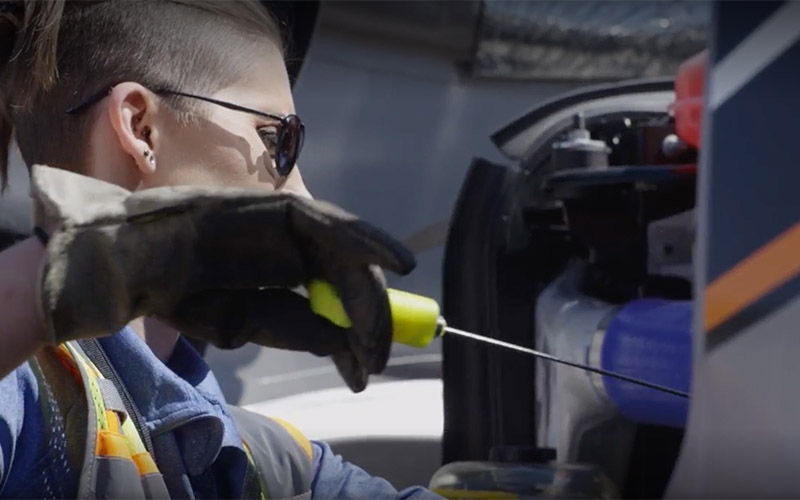
By The Schneider Guy
Estimated reading time: 4 minutes
As a truck driver, performing a CDL pre-trip inspection is one of the most common and repeated tasks you will complete. Pre-trip inspections help truck drivers ensure their tractor and trailer are safe to operat e before hitting the road.
Keep reading to learn what a p re -trip inspection is and what should be on a p re -trip inspection checklist .

What is a pre-trip inspection?
A pre-trip inspection includes checking over the tractor and trailer a truck driver will be operating . A pre-trip should be completed before the operation of a vehicle :
- At the beginning of a driver’s shift.
- Any time a new trailer is picked up.
- After a 10-hour break.
A thorough inspection usually takes anywhere from 30 minutes to one hour and should be logged as on-duty, not driving (line 4) .
How to complete a CDL pre-trip inspection
CDL pre-trip inspection checklist
1. passenger-side engine: .
- Air filter housing: Secure mounting, cover in place.
- Windshield washer fluid reservoir: No leaks, proper fluid level.
- Turbocharger: No oil or exhaust leaks.
- Engine air ductwork: No cuts, clamps secured.
- Alternator: Mounting secured, no broken or loose wire.
- Accessory drive belt: Not cracked or frayed.
- Air conditioner compressor: Secure m ounting .
2. Front brakes (covers all five brake components):
- Brake drum: No cracks.
- Brake lining: No cracks or damage.
- Slack adjuster: Proper angle to the brake chamber, clevis and cotter pin intact.
- Brake air line: No bulges or cuts, fitting tight .
- Brake chamber: Mounting bolts secured, band clamp secured.
3. Front wheel:
- Tire: ABCs (abrasions, bulges, cuts), pressure = 120 PSI, tread depth = 4/32 min ( DOT ) .
- Wheel: Not cracked or bent.
- Hub oil: Not leaking, at proper level – if it’s a sealed unit, can’t check level.
- Oil seal (outer): Not leaking.
- Valve cap: Not missing.
- Lug nuts: None missing, no streaks or shiny areas, none loose.
4. Driver side of engine:
- Radiator brace: No cracks or missing bolts.
- Radiator: Not leaking, secure mounting.
- Water pump: No cracks, not loose or leaking.
- Fuel water separator/filter: Not leaking, secure mounting.
- Pitman arm/drag link: Not cracked, castle nut secured with cotter pin.
- Steering gear box: Secure to frame, not leaking.
- Power steering reservoir: Secure mounting , no leaks, proper level.
- Dipstick: Right level, secured after check.
- Steering shaft: Secure, not loose or damaged.
- Fuel pump: No cracks, not loose or damaged.
- Oil filler cap: Secure, no cracks.
- Engine coolant reservoir: No leaks, proper fluid level.
5. Steer axle suspension:
- U-bolts: No cracks, no loose or missing nuts.
- Leak spring: No cracks, not loose or shifting.
- Tie rod: Secured with castle nuts and cotter pins.
- Shock absorber: Secure mounting, not leaking oil.
- Axle: Not cracked.
6. Rear suspension:
- Spring mount: No cracks, secure mounting.
- Tire: ABCs (abrasions, bulges, cuts), pressure = 110 PSI, tread depth = 2/32 min ( DOT ) .
- Airbag (bellows): Fully inflated, secure mounting, not ruptured.
7. Side of cab:
- Mirrors: Secure m ounting , no broken glass.
- Doors: No damage, glass not broken, hinges secured, opens and closes well.
- Lights and turn signals: Working, not cracked.
- Steps: Mounted, secured to skirting.
- Battery box: Secure m ounting , cover latched.
- DEF cap: Cap secured.
- Fuel cap/tank: Gasket in place, vent in place, chain secures the cap to the tank.
- Side skirting: No damage, panels secure.
- Side box: Secured, safety triangles present.
- Side of sleeper berth: No body damage.
- Sleeper berth window: No cracks.
8. Rear of cab:
- Electrical cord: No bare wire, no corrosion, check the plug at the end of the cord.
- Air line: Not tangled or worn, rubber grommets not worn, fittings tight.
- Cab shock absorber: Secure mounting, not leaking oil.
- Cab airbag (bellows): Not ruptured, securely mounted.
9. Driveshaft/rear frame:
- Driveshaft: Not cracked.
- Universal joint: Not cracked, not missing bolts, no shiny areas.
- Differential: Not leaking oil.
- Frame: Straight, no non-factory welds.
10. Fifth wheel area:
- Pivot pin: Keeper pin and cotter key intact.
- Slider lock pins: Fully engaged.
- Release arm: Not bent.
- Slider rail: No broken welds or missing bolts.
- Slider stop blocks: Welds not broken, not missing bolts.
- 5th wheel platform: Well-greased, tilted down.
11. Front of trailer:
- Top rail: No cracks or collision damage.
- Clearance lights: Not broken, working properly.
- Registration: Not missing, readable.
- Document box: Not missing or loose.
- Air line /glad hands: No bulges or cuts in air lines, rubber grommets not damaged on glad hands.
- Electric hook up: No broken pins, cover intact.
- PM sticker: Current, legible.
- Height sticker: Legible, legal for route.
- Placard holder: Not broken or missing rivets.
- Tracking device: No cracks or collision damage.
12. Side of trailer:
- Top rail: Not cracked, no collision damage.
- Clearance light: Not broken, operational.
- Bottom light: Not cracked, no collision damage, no missing bolts.
- Landing gear: Legs straight, no broken welds in bracing, sand pads secured and clean handle in cradle.
- Reflector tape: Clean.
- Side panels: No holes or cuts, no missing rivets.
13. Rear of trailer:
- Latches: Secured, not damaged.
- Lights: Not broken or missing, operational.
- Splash guard: Brackets and guard secured.
- License plate: Secure and clean, light is working.
- Bumper: Not damaged, no broken welds.
- Door hooks: Not loose, no missing bolts.
- Hinges: Not cracked, no missing bolts on both sides.
- Door seals: No separation, no rubber tubing sticking out.
14. Trailer suspension:
- Air line: No bulges or cuts, fittings are tight and not rubbing.
- Axle: Not bent or broken.
- Clevis pin/cotter key: Not missing.
- Slack adjuster: Proper angle, clevis pin and cotter pin intact.
- Brake linings: Minimum of ¼ inch thick, not cracked.
- Brake drum: Not cracked.
- Tire: (ABCs), tread depth = 2/32 , air pressure = 110 PSI.
- Spring: Not broken, not shifted.
- Spring mount: No broken welds.
- U bolts: Not loose, not cracked.
- Torque rod: Secure mounting, bushings intact.
- Spring brake chamber: Secure m ounting , band clamp secure.
15. Gauges/inside the truck:
- Fuel: Matches visual when looking in the tank.
- Def level: Maintain a minimum of one light bar.
- Oil pressure: 25-50 PSI.
- Speedometer: 0-60 MPH.
- Air pressure: 90-120 PSI.
Please note that the list above is just an example. It is important to remember the type of driver you are, the company you work for and the type of truck you drive can impact your CDL pre-trip inspection . Be sure to consult your company guidelines or speak with your leader for more information on your post-trip inspection requirements.
Get more great driving tips and guides.

Schneider Guy loves the "Big Orange." He's passionate about the trucking industry and connecting people to rewarding careers within it. He's been the eyes and ears of our company since our founding in 1935, and he's excited to interact with prospective and current Schneider associates through "A Slice of Orange."
Related posts

8 CDL Road Test tips to help you pass
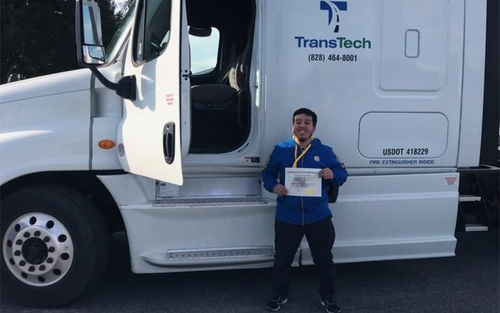
How hard is it to get a CDL?

How to get your CDL – 7 simple steps for new truck drivers


Contact Us (Se Habla Español)
- 909-201-7600 or 626-852-2000
- 4276 Elton St, Baldwin Park, CA 91706
Facebook Twitter Instagram Yelp

Class A CDL Pre-Trip Inspection Checklist & Guide

Before heading out on a route, it’s extremely important that you inspect your truck. This is not only a requirement but also essential in keeping you and others safe on the road. If you’re in the process of studying for your CDL exam, you’re probably trying to figure out how to remember all the pre-trip inspection items and wondering how you’ll check all those items before every trip. Fear not! While memorizing these inspection items is necessary for the test, your pre-trip inspection will likely be a little bit shorter on a daily basis.
Not sure what is essential to look at during your CDL pre-trip inspection ? Check out our CDL pre-trip inspection checklist below for a concise list of the main items you’ll need to look at before every trip. This list is not exhaustive though, so be sure to add anything that may be specific to your truck.
CDL Pre-Trip Inspection List
While the DOT isn’t explicit with which items drivers are required to inspect during their pre-trip inspection, it is important to take a look at the following items:
- Service brakes, including trailer brake connections
- Parking (hand) brake
- Steering mechanism
- Lighting devices and reflectors
- Windshield wipers
- Rear-vision mirrors
- Coupling devices
- Wheels and rims
- Emergency equipment
Your company may have additional requirements, but the items listed above are all necessary to include in your daily vehicle inspection report (DVIR). Your DVIR should be completed post-trip, but it’s beneficial to review all list items prior to setting off on your trip as well.
When completing a Class A CDL pre-trip inspection , here is a more detailed list of items that you should check. Again, it’s important to note that these are not the only items you should be checking – this is just a good starting point.
Under the Hood
- Fluid Levels (including oil, coolant, and windshield washer fluid)
- Fluid Leaks
- Damage to Hoses and Belts
- Damage to Wiring
- Steering Shaft
- Air Compressor
Side of Cab
- Lights and Turn Signals
- Fuel Cap and Tank
Rear of Cab
- Electrical Cord
- Drive Shaft
- Pivot Pin and Slider Lock Pins
- 5th Wheel Platform
- Release Arm
Front of Trailer
- Inspection Sticker
- Registration
- Clearance Lights
- Height Sticker
- Header Board
Side of Trailer
- Clearance and Bottom Lights
- Landing Gear
Back of Trailer
- Doors (including hinges, latches, and seals)
- License Plate
As time goes on, you’ll become more and more comfortable with completing a pre-trip inspection. Don’t let yourself get too comfortable though. These inspections are extremely important and require the utmost care and attention. If you don’t complete a thorough inspection, you’re putting yourself and others at risk, so treat each inspection with the same attention to detail.
If you want to learn more about conducting a pre-trip inspection and what you should be looking for when inspecting each of the items above, our CDL training covers everything you need to know. Get started on your CDL training today!

- All Companies
- Driver Training
- All Freight Types
- Lease/Purchase
- Message Board
- Truck Driver Salary
- How to Become A Truck Driver
- Will I Be Successful?
- Truck Driving Schools
- CDL Practice Tests
- Get Your CDL
- Get Your First Truck Driving Job
- Your First 100,000 Miles
- Advanced Tips
- Sign Up Here
Select Location x
Please tell us your location.
Location not set
The Complete Pre-Trip Inspection Checklist
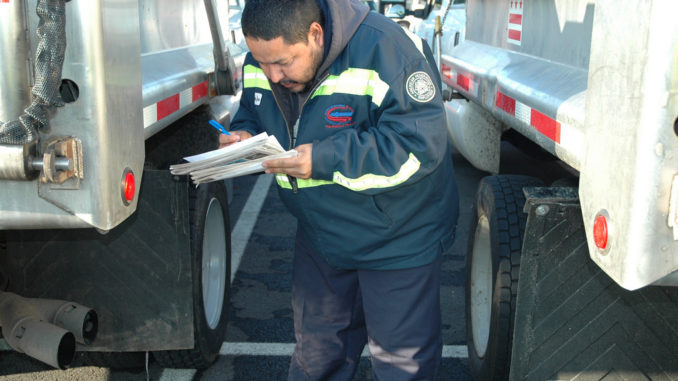
Due to heavy memorization, the pre-trip inspection is one of the hardest aspects of the CDL test. Also called the “Vehicle Inspection Test,” the pre-trip is one of the tests that trucking students fail the most.
With this pre-trip inspection checklist, we tell you everything you need to know and what you need to check for.
Engine Compartment – What to Check For:
When checking the engine compartment, you always want to make sure the following components are properly mounted and secured. You should also make sure they are not cracked, bent, or broken. The items you need to check for include:
Belt-Driven Alternator
All of the wires are connected. The belt is not cracked or frayed, and the free play on the belt is between ½ to ¾ of an inch.
Belt-Driven Water Pump
The free play on the belt is between ½ to ¾ of an inch, and all the hoses running to and from the water pump are tightly clamped. Ensure nothing is leaking.
Brake Chamber
The brake chamber is not leaking air.
The brake drum is properly mounted and secure.
The brake hose is rubber; it is not cracked and is not leaking air.
Brake Lining
Check for oil or debris on the lining. There should be at least ¼ of an inch of friction material.
Caste Nuts and Cotter Pins
All three caste nuts and cotter pins are present.
Coolant Reservoir
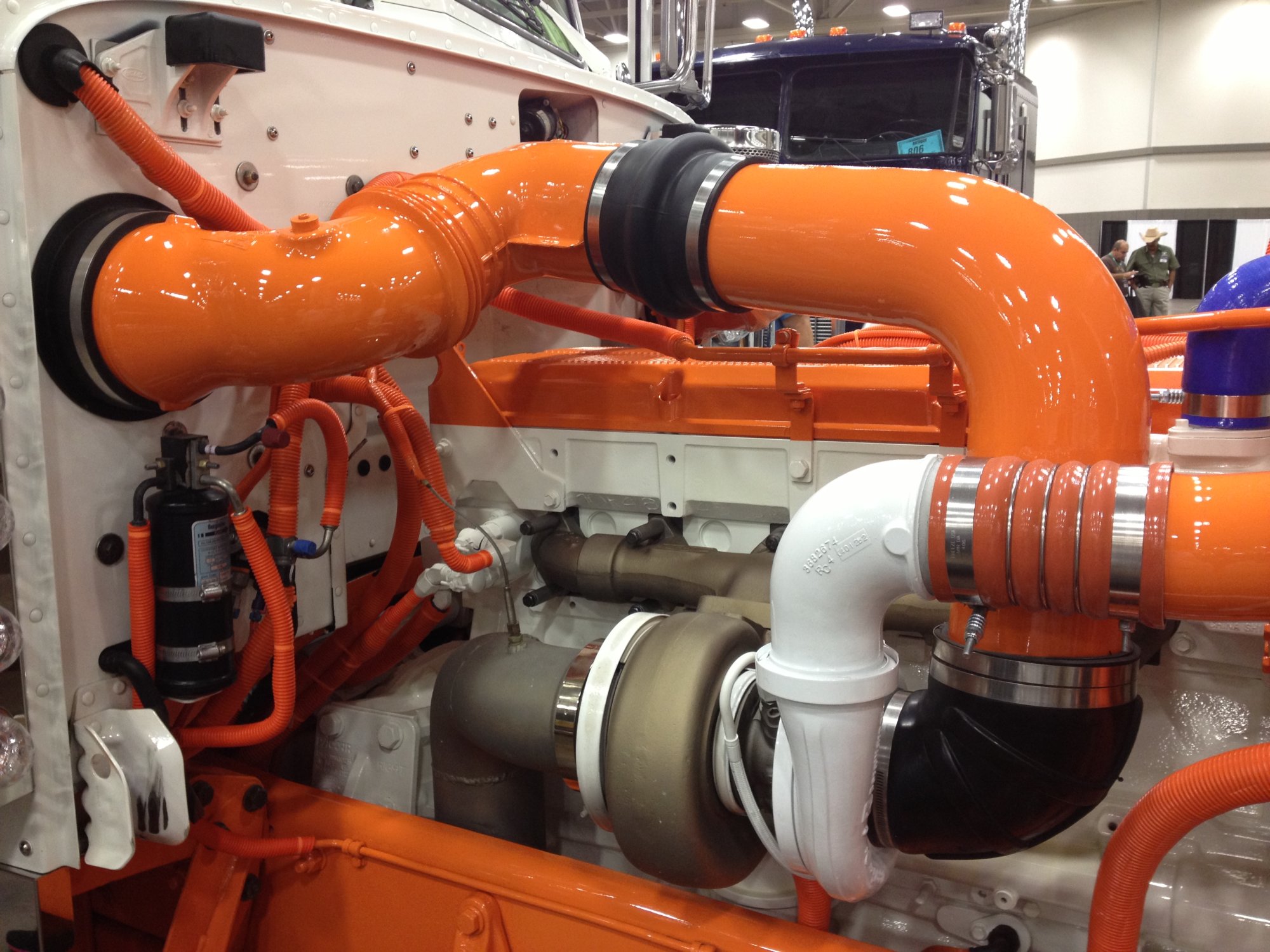
The reservoir is not leaking and is filled to the manufacturer’s specifications.
The drag link is properly mounted and secure, and not cracked, bent or broken.
Gear Box and Hoses
The gear box and hoses have no abrasions, bulges or cuts, and are not leaking.
Gear-Driven Air Compressor
The air compressor is properly mounted and does not leak.
Gear-Driven Power Steering Pump
The steering pump is properly mounted and not leaking.
General Hoses (Passenger and Driver’s Side)
The hoses are secure at both ends and are not leaking. There are no abrasions, bulges, or cuts.
The hub seal (or axle seal) is leaking and is filled to the manufacturer’s specifications.
Leaf Springs
None of the leaf springs have shifted or are bent or broken.
There are no signs of leaks under the truck.
There are no lug nuts missing. There are no rust trails, powder residue, or cracks around the bolt holes.
The oil level is filled to the manufacturer’s specifications.
The pitman arm is properly mounted and secure. It is not cracked, bent, or broken.
Power Steering Fluid Reservoir
The power steering reservoir is not leaking and is filled to the manufacturer’s specifications.
The rim does not have any unauthorized welds.
Shock Absorber
The shock absorber is not leaking. If it is leaking, the leak will be at the point where the top and bottom portion of the shock meet.
Slack Adjuster and Push Rod
With the brakes released and pulled by hand, the push rod does not move more than one inch.
Spring Hanger
The spring hanger is properly mounted and secure.
Steering Column
The steering column is properly mounted and secure. It is not cracked, bent, or broken.
There are no abrasions, bulges, or cuts on the tread or sidewalls. Tread depth should have a depth no less than 4/32 of an inch. Tires are properly filled to the manufacturer’s specifications. This can be checked with an air gauge.
The tie rod is properly mounted and secure, not cracked, bent, or broken.
Make sure all are accounted for.
Driver Door Fuel Area-What to Check For:
Remember – during the pre-trip inspection, you want to make sure these items are properly mounted and secure. Look for cracks, bends, and breaks.
The actual airbag has no abrasions, bulges, cuts, or leaks. The airbag is not missing mounting bolts.
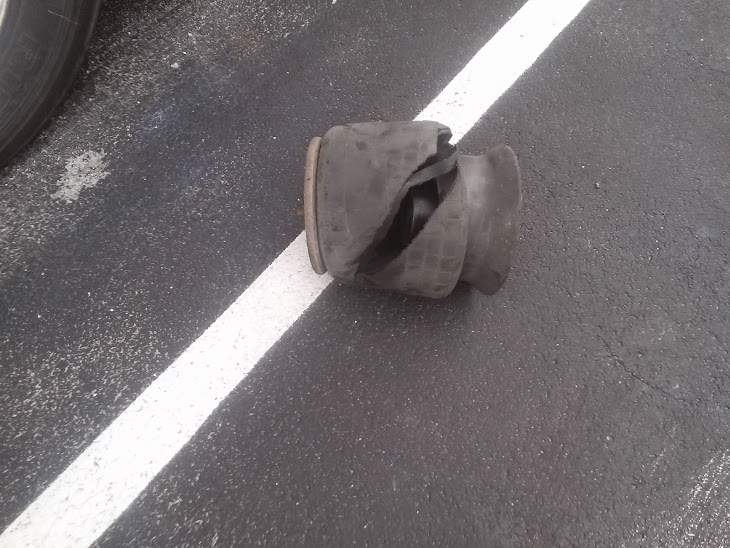
The axle seal is not leaking and is filled to the manufacturer’s specifications.
The brake drum is secured properly and has no cracks, bends or breaks.
Check the brake hose at both ends to make sure it is not leaking air.
There is no oil or debris on the brake lining. There is at least ¼ of an inch of friction material.
Catwalk and Steps
The cat walk and steps are clear of any loose objects.
Door and Hinges
The doors open, close, and latch properly. Door seals should not be worn, torn, or rotten.
Drive Shaft
The drive shaft is not twisted, and the u-joints are free of any debris.
The tread and sidewalls have no abrasions, bulges, or cuts. The tread depth is no less than 2/32 of an inch. Tires are properly filled to the manufacturer’s specifications. This can be checked with an air gauge.
Exhaust System
The exhaust system shows no signs of leaks.
Frame and Cross Members
There are no unauthorized holes or welds. Bundle up the cross members to ensure none are missing.
Fuel is not leaking from the tank, and the cap is on tight.
There are no rust trails, loose bolts, powder residue, or cracks around the bolts.
Mirrors are clean, with no cracks or chips.
The mud flap is secured properly, with no cracks, bends and breaks.
There are no unauthorized welds.
The shock absorber is secure at both ends and not leaking. If it does leak, it is preferable to leak in the middle.
There is proper spacing between the tires and there is nothing stuck.
The spring arm is secure at both ends.
Spring Mount
The spring mount is secure at both ends.
The torque arm is secured properly, with no cracks, bends or breaks.
No u-bolts are missing.
Coupling Area-What to Check For:
Air lines should be secure at both ends with no abrasions, bulges, or cuts. They should not be leaking, dragging, or tangled.
Make sure the apron is properly mounted and secure. Look for cracks, bends, and breaks.
Make sure there is enough space between the tractor mud flap and the trailer landing gear, so that they don’t hit each other when making a turn.
Electric Line
The electric lines are secure at both ends. There are no abrasions, bulges, cuts, or exposed wires.
There is no space between the apron and the skid plate.
The seals are in good condition with no cracks, signs of rotting, or leaking air.
The king pin is properly mounted and secure, without cracks, bends and breaks.
Locking Jaws
Physically check that the locking jaws are fully locked around the king pin.
Mounting Bolts
No mounting bolts are missing.
The platform is properly mounted and secure, without cracks, bends and breaks.
Release Arm
The release arm is in the fully locked position.
The skid plate is properly lubed.
Sliding Fifth Wheel Locking Pin
The pin is in the fully locked position.
Trailer- What to Check For :
The airbag has no abrasions, bulges, cuts or leaks, not missing any mounting bolts.
The brake chamber is properly mounted and does not leak air.
The brake hose is secure at both ends with no abrasions, bulges, cuts, or leaks.
No oil or debris on the brake lining and at least ¼ of an inch of friction material.
No missing cross members.
Header Board
The header board does not have any holes or missing rivets.
Landing Gear
The landing gear is fully raised and the cradle handle secure.
No rust trails, powder residue, or cracks around the bolt holes.
The rims do not have any unauthorized welds.
Rear Door and Hinges
The rear door opens, closes, and latches properly. Door seals are not worn, torn, or dry rotten.
The shock absorber is secure at both ends with no leaks.
When the brakes are released and pulled by hand, the push rod does not move more than one inch.
Tandem Frame and Release
Release handle and locking pins are in the fully locked position.
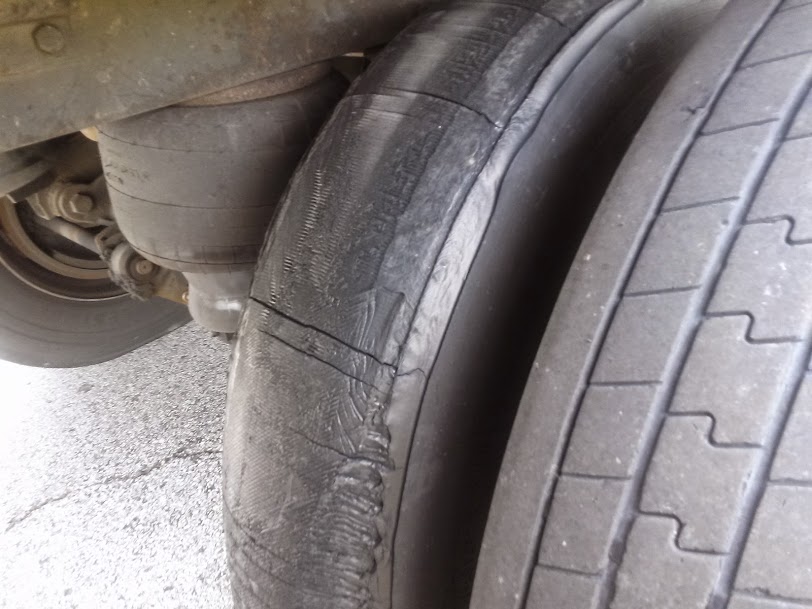
Trailer Tire
There are no abrasions, bulges, or cuts to the tread or sidewalls. Tread depth is no less than 2/32 of an inch. The tire is properly filled to manufacturer’s specifications and checked with an air gauge.
Light Check
There are five locations where you must check your lights. These include:
- Front of the truck
- Both sides of the truck
- Rear of the truck
- Both sides of the trailer
- Rear of the trailer
The five functions are:
- Left turn signal
- Right turn signal
- Four way flashers
- High/low beams
- Brake lights
Inspection and Brake Tests-What to Check For: In-Cab
The last section is In-Cab Inspection and Brake Tests. For the In-Cab Inspection you once again want to make sure all of the following components are properly mounted and secure. As well as the following:
Air Brake Test
There are three stages to an air brake test:
- Applied Pressure Test – When doing the Applied Pressure Test, you want to build the air pressure to governor cut out. Put the truck in the lowest gear, turn the engine off and immediately turn it back on. Push in the tractor and trailer valves which then release the parking brakes. Push and hold the brake pedal, allowing the gauges to stabilize. When the gauges have stabilized, announce the Primary and Secondary PSI. Listen for air leaks while doing this.
- Warning Light and Buzzer – Pump down on the brake pedal until the warning light and buzzer comes on. This is typically at or before 60 PSI.
- Tractor/Trailer Protection Valve Pop Out – Pump down on the brake pedal until the tractor and trailer protection valves pop out, this will be between 20 and 40 PSI.
Air Pressure Gauges
The air pressure gauges build to governor cut out.
Emergency Equipment
Truck has a fire extinguisher, three red reflective triangles, and spare electrical fuses.
Heater and Defroster
Demonstrate both the heater and defroster are working properly.
Horns (Air Horn and City Horn)
Blow both horns to make sure they are working.
Lighting Indicators
Check the left turn, right turn, four way flashers and high beams; also point these out on the dashboard.
With the transmission in neutral, fully depress the clutch. Turn the key on, check the ABS light, announce when it comes on and off, and start the engine.
The seat belt is not ripped or frayed and adjusts and latches properly.
Oil Pressure Gauge
The engine oil pressure gauge should rise to normal operating range.
Parking Brake
- Trailer Parking Brakes – Set the trailer brake, release the tractor brake, and tug lightly on the trailer.
- Tractor Parking Brakes – Set the tractor brake, release the trailer brake, and tug lightly on the trailer.
Service Brake Check
Release both the tractor and trailer brakes. Drive at idle speed. Apply the service brake to make sure you come to a complete stop and that it doesn’t pull to the left or right when applying the brakes.
The voltmeter is charging between 13 and 14 volts.
Water Temperature Gauge
The water temperature gauge rises to normal operating range.
Windshield and Mirrors
The windshield and mirrors are clean, with no obstructions and in proper adjustment.
Windshield Wipers and Washers
Demonstrate the wipers and washers are working properly by spraying the windshield.
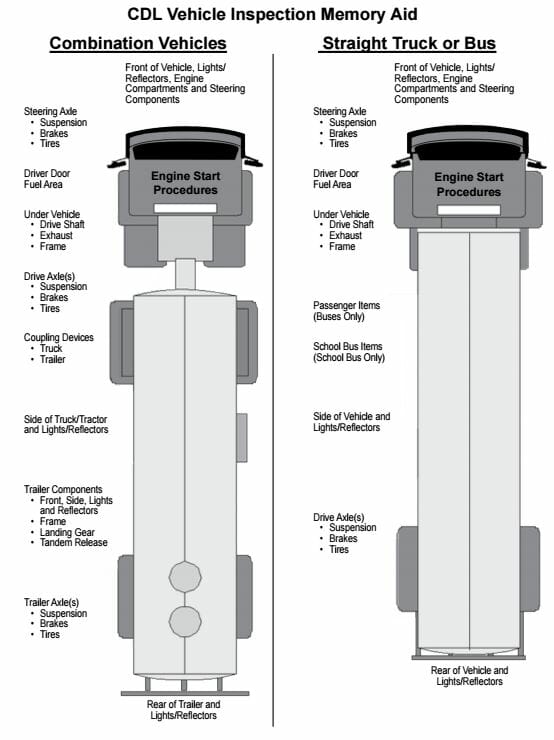
This is a really nice complete list, very useful.
Comments are closed.
Contact ClassADrivers.com
Please use the form below to contact our customer service or sales team.
You can also reach us at (888) 830-2326. Our normal business hours are Monday-Friday 8 a.m. to 5 p.m. (Pacific Time).
Our business address is: Attn: Class A Drivers MH Sub I, LLC dba Internet Brands 909 N Pacific Coast Highway, 11th Floor El Segundo, CA 90245
By clicking the ["Send"] button, you agree to our Terms of Use and Privacy Policy , and to the use of cookies described therein, and you also consent to the collection, storage, and processing of your data in the United States where the level of data protection may be different from that in your country.

- Register / Login
- Trucker's Forum
- Paid CDL Training
- Truck Driving Jobs
- CDL Practice Tests
- High Road Training
Pre-Trip Inspection Study Guide

Our Pre-Trip Inspection Study Guide has everything you need to prepare for the Class A CDL Pre-Trip Inspection Exam . Our study guide will cover the pre-trip inspection terminology as well as a thorough list of all of the parts you will be inspecting on the vehicle. For each part you will be inspecting there will also be a list of items you will be checking for. Our study guide is broken down into the following sections:
- What You Need to Know About Pre-Trip Inspection
Pre-Trip Inspection Practice Questions
- Pre-Trip Inspection Checklist
Pre-Trip Inspection Videos
Pre-trip inspection printable resources, what you need to know about the pre-trip inspection.
The Pre-Trip Inspection is a thorough inspection of the vehicle and all of its major systems. Inspecting the vehicle before driving each day is a Federal requirement and normally takes about 15 minutes. It must be logged in your logbook as "on duty not driving."
You will have to do thorough safety inspections of the coupling system, the vehicle lights, engine compartment, tires and brakes, the chassis, the fuel tanks, and an in-cab inspection.
The following information is a brief summary of Daniel's Complete Pre-Trip Inspection taken from our oustanding free PDF download:
Engine Compartment
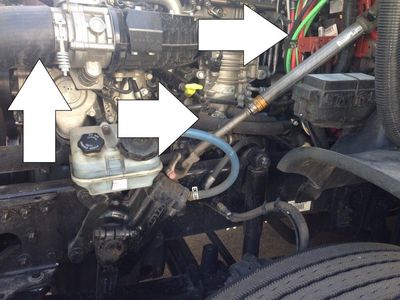
You will be checking the engine compartment for any sort of leaks. You will also be checking to see if all components are properly mounted and secured. None of the mounts must be cracked, bent, or broken.
You will be checking all hoses to make sure they aren't leaking, frayed, or sliced and the fluid levels including the oil level, the coolant, and the power steering fluid.
You must check the components like the water pump, the power steering pump, and the alternator to make sure nothing is leaking, the belts are not frayed, and that everything is properly mounted and secured.
From inside the engine compartment you will also find the steering system, the front suspension system, and the front brake system. All components of these systems must be properly mounted and secured without anything being cracked, bent, or broken. Finally you will be checking the tires, rims, and axle seals to make sure the tires are properly inflated, the rim isn't bent or cracked, and the axle seals are not leaking.
Fuel Tank And Battery Area

You will be standing along the side of the tractor doing a series of checks on the mirrors, fuel tanks, batteries, exhaust system, and more. You will check to make sure nothing is bent, cracked, broken, or leaking.
Check the mirrors, door hinges, door handle to make sure nothing is cracked, bent, or broken. Check to make sure there is no fuel leaking and that the fuel cap is secured and the gasket is not missing.
Check the exhaust system to make sure nothing is cracked, bent, or broken. Check the driveshaft, cat walk, and steps to make sure nothing is cracked, bent, or broken.
Check the frame and crossmembers for structural integrity. Check the air lines going to the trailer to make sure they're properly connected and that there are no abrasions, bulges, or cuts. Make sure the gaskets are present.
Check the suspension system and brakes on the drive axles, making sure nothing is cracked, bent, or broken. Make sure the brake linings are the proper thickness and that the air bags and properly inflated. Inspect the brake chambers, slack adjusters, and pushrods are properly mounted and secure. Not Cracked, Bent, or Broken. With the brakes released and pulled by hand, the Push Rod should not move more than 1 inch.
Check the rims, tires, and axle seals of the drive tires for proper inflation, no leaks around the seal, and the lugs are all present and secured.
Coupling System

You will be standing where the tractor and trailer are connected and you'll start by checking the electrical line and air lines to make sure they're properly mounted and secure at both ends. No abrasions, bulges or cuts. Not leaking air. Make sure the electrical line has no wires exposed. Check the gladhands to make sure the seals are in good condition, no cracks or signs of dry rotting. Not leaking air.
Check the skid plate of the fifth wheel and the apron of the trailer to make sure there is no debris and nothing is cracked, bent, or broken. Make sure the fifth wheel is properly greased. Also make sure there is no gap in between the fifth wheel and the trailer apron once the tractor and trailer are coupled. Make sure the kingpin of the trailer is properly mounted and not cracked, bent, or broken and that the locking jaws of the fifth wheel are properly secured when the tractor and trailer are coupled.
Check the mounting bolts where the fifth wheel attaches to the tractor frame. Make sure there are no missing bolts and that everything is secured properly. Check the locking pin if you having a sliding fifth wheel to make sure it's properly locked into place.
Make sure that there is the proper clearance space between the tractor mudflap and the trailer landing gear so that they don’t hit each other when making a turn.

You will start inspecting the trailer at the head board, which is the front wall of the trailer. Make sure there are no holes or missing rivets. Check the landing gear to make sure it is properly mounted and secure. Not cracked, bent, or broken. Make sure the fully raised and the handle is secure in the cradle when the tractor and trailer are coupled.
Check the frame and crossmembers under the trailer to make sure they're not cracked, bent, or broken. Check the tandem frame and release pins to make sure the frame is in good condition and the release handle and locking pins are in the fully locked position.
You will check the entire suspension and brake system for the trailer tandems the same way you did for the drive axles of the tractor. You will also make sure the mudflaps are properly secured. For dual tires check to see that there is proper space between the tires and there is nothing stuck between the tires.
Check the rear door and hinges to make sure they are properly mounted and nothing is cracked, bent, or broken. Make sure the door seals are not worn, torn, or dry rotted.
Light Check

You will be checking all of the lights and reflectors on both the tractor and the trailer. Check the reflectors and reflective tape to make sure they are properly mounted and secure, not cracked, bent, or broken, and clean and illuminated. Check that you have the proper color of amber to the front and sides, and red to the rear.
Start by turning on your marker lights and headlights. Now walk around the entire truck and trailer and point out the lights. Give the function of the light and the location. You should then ask your examiner to help you check your five functions.
While you're sitting in the drivers seat, the examiner will stand to the front of the truck, then behind the trailer. He will then check your Turn Signals, Four Way Flashers and Brake Lights. You must do each function at every location.
The five locations that you must check your lights:
- Front of the Truck
- Both sides of the Truck
- Rear of the Truck
- Both sides of the Trailer
- Rear of the Trailer
The Five Functions you are checking for:
- Left Turn Signal
- Right Turn Signal
- Four Way Flashers
- High Beams/Low Beams
- Brake Lights
In-Cab Inspection
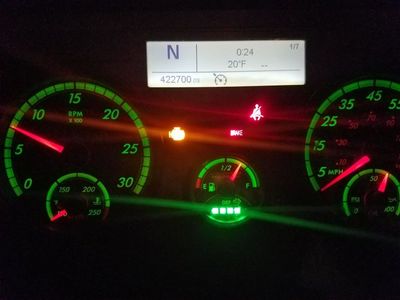
The in-cab inspection and air brake check will cover the various gauges and systems inside the cab along with several tests to make sure you air brake system is working properly.
You will start by checking the following:
- Seat Belt- Properly Mounted and Secure. Not ripped or frayed Adjusts and latches properly.
- Fire Extinguisher- Properly Mounted and Secure. Fully charged
- Three Red Reflective Triangles- My three red reflective triangles are GIVE LOCATION
- Spare Electrical Fuses- My spare electrical fuses are GIVE LOCATION
- Volmeter, Oil Pressure Gauge, Water Temperature Gauge, and Air Pressure Gauge all show proper operation
- City horn and air horn functioning properly
- The windshield and mirrors are clean, no cracks or breaks, no obstructions. The mirrors are in proper adjustment.
- Windshield Wipers and Washers - Demonstrate that the washers work by spraying the windshield. The Wipers are: Properly Mounted and Secure and operate smoothly. The blades aren't cracked or dry rotten.
- Heater and Defroster - Demonstrate that both the Heater and Defroster are working properly.
- Lighting Indicators - Left Turn, Right Turn, Four Way Flashers, and High Beams.
Trailer Parking Brakes - Set the Trailer Brake, release the tractor brake, and then tug lightly on the trailer.
Tractor Parking Brakes- Then set the Tractor Brake, release the trailer brake, and then tug lightly on the tractor.
Service Brake Check - Release both Tractor and Trailer Brakes. Now drive at idle speed. Apply the Service Brake to make sure you come to a complete stop, and that it doesn't pull to the left or right when applying the brakes.
Air Brake Test
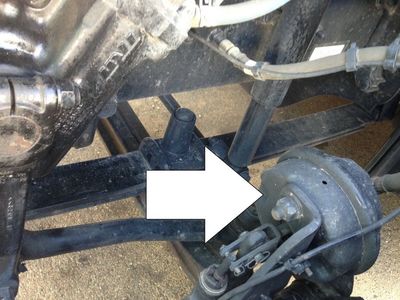
The air brake test will consist of a leakdown test to make sure your air brakes aren't leaking air and losing pressure. It will also test the warning lights and buzzer to make sure the driver gets the proper warning if the air pressure drops too low.
There are three stages to an Air Brake Test
#1: Applied Pressure Test
#2: Warning Light and Buzzer
#3 Tractor/Trailer Protection Valve Pop Out
Applied Pressure Test: Build the air pressure to governor cut out. Put the truck in the lowest gear. Then turn off the engine Immediately turn the engine back on. Push in both the tractor and trailer valves. (This will release the parking brakes.) Push and hold the Brake pedal fully. Allow the gauges to stabilize. Announce the gauges have stabilized and the Primary and Secondary PSI. With the Brakes fully pressed, you should not lose more than 4 PSI in one minute. Announce that you are listening for air leaks during that minute.
Warning Light and Buzzer Test: Pump down on the Brake pedal until the warning light and buzzer comes on, at or before 60 PSI.
Tractor/Trailer Protection Valve Pop Out Test: Pump down on the brake pedal until both the tractor and trailer protection valves pop out. They should both pop out between 40 and 20 PSI.
We have a ton of Pre-Trip Inspection Practice Questions along with the answers and a complete scoring system in our Free Online CDL Practice Tests :
The Engine Compartment Section will include questions about checking the oil level and coolant levels, inspecting belt-driven engine components (like the water pump, alternator, and air compressor), and the safety devices required in the cab. There will also be questions regarding the windshield wipers and free play in the steering wheel.
The Lights And Brakes Section will include questions about dashboard indicator lights, inspecting the parking brakes, and doing a leakdown test on the air brakes. It will also include questions about the low air pressure warning signal and testing your air horn and city horn.
The Suspension And Steering Section will include questions about the tractor protection valve, inspecting the steering box, and inspecting many suspension system parts. It will also include questions about welds being present on tire rims and the minimum tread depth required on steering axle tires.
The Tires And Coupling Devices Section will include questions about shiny trails or rusty threads on lug nuts, inspecting the battery box and cover, and inspecting electrical lines. It will also contain questions about inspecting the coupling devices and the fifth wheel skid plate.
The Emergency Equipment And Fifth Wheel Section will include questions about additional emergeny equipment required by school buses, inspecting the gap between the kingpin apron and the fifth wheel skid plate, and the landing gear securement. It will also contain questions about inspecting driver mirrors and the trailer frame.
Pre-Trip Inspection Checklist - Class A
Our pre-trip inspection checklist covers every part of the truck from front to back, both inside and outside of the truck. It covers the air brakes, suspension parts, steering components, wheels and rims, fuel tanks, batteries, lights, and more. It also covers the air brake tug test and checks for everything under the hood including alternator, water pump, fuel pump, fluids, and more.
This is a super handy checklist to study anytime you have a few minutes to spare:
Pre-Trip Inspection Checklist - Free Word Document Download (Editable Version)
Pre-Trip Inspection Checklist - Free PDF Download (Print Version)
Pre-Trip Inspection Video By Apex CDL Institute
Jeff from Apex Institute does an in-depth explanation of the entire pre-trip inspection process. This video is loaded with tips that go beyond the CDL test to help drivers really understand how to identify problems.
Pretrip Inspection Self-Test By CDL College
The Pretrip Inspection Self-Test By CDL College is really unique. It's a silent video which will show you the part you're inspecting and then gives you a few seconds to figure out what you should be checking for before giving you the answer. Definitely check this one out. Great for practicing before the CDL exam.
Pre-Trip Inspection Video By Averitt Express
This is a complete back to front pre-trip inspection of a truck and trailer by Averitt mainentance associate Kevin Breeding. This thorough pre-trip inspection covers all inportant points of inside the cab, lights, engine, the tractor itself and the trailer.
We have included two print versions of the pre-trip inspection process from Daniel. The first is the entire pre-trip inspection and the second is an abbreviated checklist for the inspection.
- PDF: Daniel's Pre-trip Inspection (Print Version)
- PDF: Daniel's Pre-trip Inspection Checklist (Print Version)

Why Join Trucking Truth?

- The High Road Training Program
- The High Road Article Series
- The Friendliest Trucker's Forum Ever!
- Email Updates When New Articles Are Posted
Apply For Paid CDL Training Through TruckingTruth
Did you know you can fill out one quick form here on TruckingTruth and apply to several companies at once for paid CDL training? Seriously! The application only takes one minute. You will speak with recruiters today. There is no obligation whatsoever. Learn more and apply here:
- Privacy Policy

- Free Practice Tests
Commercial Driving
- Introduction
Getting a CDL
- Fees and costs
CDL Types & Permits
Endorsements & Restrictions
CDL Exam Preparation
Written exams
Practical exams
- Skills test
- Pre-trip inspection
- TSA background check
- Retake policy
CDL Maintenance
ELDT Training & Certification
CDL how-to guides
CDL Pre Trip Inspection: Step by Step Guidelines

What is a Pre-Trip Inspection?
A pre-trip inspection is a thorough checkup of your truck to keep public safety and ensure there is no malfunction before starting your journey. A common pre-trip inspection process involves inspecting fluid levels, leaks, tires, brakes, clutch, shock absorbers, fifth wheel, and many other components. After finishing your pre-trip inspection, file your work on a DVIR (Driver Vehicle Inspection Report). Any issues detected must be addressed before departing. A thorough vehicle pre-trip is required by law and takes approximately 30 minutes.
The Pre-Trip Vehicle Inspection Test
To obtain your CDL exam, you need to complete a pre-trip inspection test. You will have no more than 50 minutes to complete a pre-trip vehicle inspection for the state examiner. During the exam, you should identify each part and tell the examiner what you are looking for or inspecting. Within each area, there are multiple parts you must identify.
CDL Pre-trip inspection guide (Step by step)
Follow this four-step process for each part inspected:
After finishing the four-step pre-trip inspection process for each engine part, you can fill in your results in the Pre-trip Inspection Form .
CDL pre-trip inspection checklist
Below is a detailed CDL pre-trip inspection checklist of the different parts of a pre-trip.
Front of tractor
Your pre-trip examination begins at the front of your tractor. Make sure that the reflectors, lenses, and lighting fixtures are clean, undamaged, and properly maintained. Make sure they are reflective and functional. The headlights ought to receive the same attention. It is crucial to have a good line of sight in front of your truck when it comes to safe driving.
Engine Compartment
You specifically check the mounting and operation of your turbocharger, air cleaner, oil level, hoses, pumps, brakes, shock absorbers, brake calipers, brake pads, tires and rims, air pressure, and seals on the passenger's side of your vehicle.
Coupling area
The coupling area in Class A vehicles involves 3 main parts
- Fifth Wheel Type: Mounting Softs, Platform, 5' Wheel Skid Plate, Release Arm, Kingpin, Apron, Sliding 5" Wheel Locking Pins.
- Pintle Hook/BaII Hitch Types : Mounting Bolts/wields, Pintle Hook/Ball, Safety Latch/Locking Device, Safety Chain/Cables, Eye/Coupler, Drawbar/Tongue.
- Tow Truck - Underlift Type: Underlift Reach, Pivot Pin, Crossbar, Receiver Retaining & Safety Pins, Tie-Down Chains or Straps, Safety Chains.'Cables.
Driver door fuel system
- When it comes to airbags, you must look for cuts, abrasions, leaks, bulges, and missing bolts.
- The axle seal must be filled and should not leak in accordance with specifications.
- Ensure that neither the brake hose nor the brake chamber is leaking air.
- The catwalk and steps need to be mounted and free of any loose objects for the truck driver's safety.
Side of truck
The trailer should basically stay the same as when it was initially loaded and attached to the tractor. But before you leave, make sure that everything is in working order. The landing assembly, handles, frame & cross members, tandem release, lights, and reflective tape should all be functional. Verify the trailer for body dents or rusty areas.
Rear of truck
The rear of the trailer is rather simple to inspect. Make sure your license plate is affixed and clearly visible, and check all the reflectors and lights. Confirm that the doors are shut and secured. Ensure the brake lights are in working order.
In-cab Inspection
Here is the list of parts included in the in-cab inspection process:
- Safety Belt
- Lighting indicators
- Oil Pressure Indicator
- Air Pressure Gauge
- Ammeter/voltmeter
- Wipers and Washers
- Heater/Defroster
- Safety/Emergency Equipment
Brake Check
Here are the checklists for inspecting your braking system
- Hydraulic Brake Check/Air Brake Checks (depending on your truck)
- Breakaway Module
- Parking Brake
- Service Brakes
If your truck uses air brakes, it is important to note that the air pressure must be greater than 100 psi to 120 psi to verify the air brake. Pump brakes, 60 psi warning lights, and pump brakes, 40 psi - 20 psi valves pop. Press pedals no more than 4 psi loss.
How to remember Pre-Trip Inspection for CDL exams
Get ready for the CDL exams with our CDL Prep App , providing a variety of exam-like Questions and state-specific practice tests.
- What can you do at an accident site to help avoid another accident?
- Which of the following drivers is NOT exempt from obtaining a CDL, under Florida law?
- Which of the following will affect your ability to drive upon your very first conviction?
- You are required to inspect your truck within how many miles after beginning the trip?
- Should brake adjustment be checked often?
- The application pressure gauge shows how much air pressure you:
- If your vehicle has an alcohol evaporator, every day during cold weather you should:
- How should you check that the spring brakes come on when the air pressure in the system drops below a certain level?
- You are coupling tractor to a semitrailer. You have connected the airlines. Before backing under the trailer you should:
- You should adjust the outside left and right side flat mirrors to see:
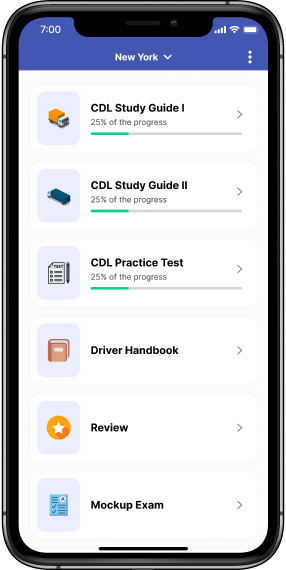
CDL Prep holds all the qualities that make it so magical!
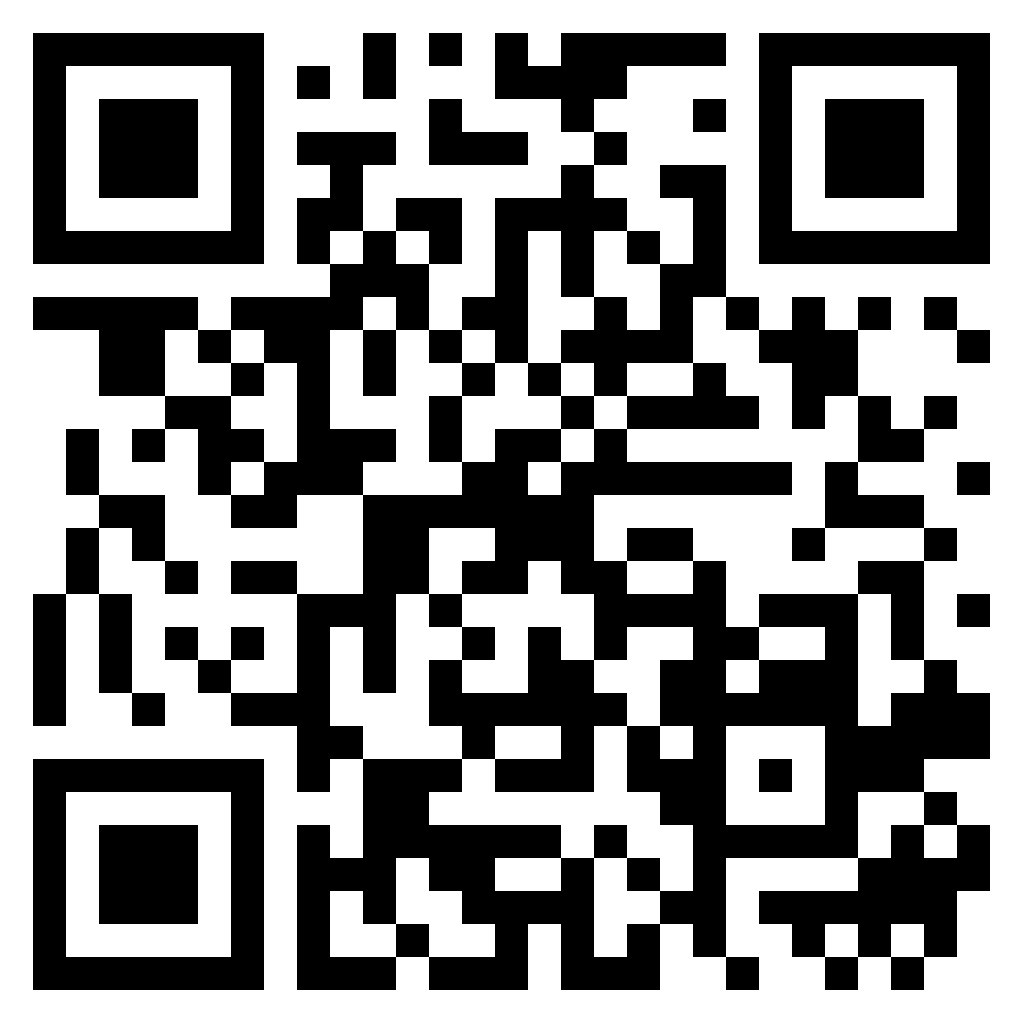
Best Free CDL Pre-Trip Inspection Checklist | Trucker Safety & Profit

Brian Smith
October 9, 2023

The indispensable CDL pre trip inspection checklist is one of the most important rituals of a driver's day. Industry veterans know this routine like the back of their hands—it's that vital to the trade— but new drivers struggle with how to remember their CDL pre trip inspections, especially for the exam.
Drivers are required to complete this walkthrough at least every 24 hours, after their mandatory 10-hour break. A detailed inspection can safeguard not only your safety but also that of everyone else on the road.
This article will walk you through an exhaustive checklist to follow before every trip, as well as the potential costs of not doing so. We've designed this list with YOU in mind, so we're throwing in some money-making tips that will help you avoid steep fines and costly repairs.
"Spotting and fixing vehicle defects early on keeps you safe and your truck in good shape."

Why Following the CDL Pre-Inspection Checklist is So Important
The price of a failed DOT inspection makes completing a thorough CDL pre trip inspection checklist even more pressing. Violations can cost carriers thousands each year in both penalties and out-of-service (OOS) trucks. According to the FMCSA, around 20% of vehicles are OOS due to failed inspections at any given time. For an owner-operator, this means you'd be paying thousands in vehicle payments on a truck that's not earning you any money.
The pre trip checklist is designed to avoid any possible accidents due to equipment failure and failed safety inspections. A few minutes of caution pays for itself ten-fold down the line.
DOT & Truck Inspection
- Steer Axle/ Rear Suspension
- Side of Cab
- Rear of Cab
Driver Shaft/Rear Frame
- Trailer Front/Side/Rear- Trailer Suspension
Gauges/Inner Truck
- DVIR form fill out
"Most pre-trip truck inspection lists cover safety. We go beyond that with time and money-saving tips in our pre-trip inspection checklist PDF." - Brian Smith, Director, Global Marketing of Cota Systems
- Get the Google Sheet
- Download the Printable PDF
General Tips Throughout Your Pre-Trip Inspection
Because you don't have access to a pre trip inspection checklist during the CDL exam, drivers have created a few tricks to pass this part of the test. The most common memorization tricks are:
BBC: Is any plastic or metal bent, broken, or cracked?
CDL: No hard materials should be cracked, damaged or loose.
ABC: Are there any abrasions, bulges, or cuts on the rubber?
PFL: Peak for leaks in fluid and air containers.
PMS: Are bolts properly mounted and secure?
ABCDF: Do you see abrasions, bulges, cuts, dry rot, or frays?
A bit of common sense will help you put these acronyms to good use. For example, there's no way BBC would apply to rubber, as rubber wouldn't be bent, cracked, or broken. Most drivers pick one for each material type and stick with it until they get more comfortable with the list.
What are the ABCS in a pre-trip inspection?
As mentioned above, the ABCs refer to Abrasions, Bulges, and Cuts to check for during the Class A CDL pre-trip inspection. This applies to rubber or soft surfaces - things like tires, hoses, and rubber bushings.
How Long Should a Proper CDL Checklist & Inspection Take?
Ideally, it takes 15-30 minutes to run through the CDL pre trip inspection checklist depending on experience level and whether or not any issues are found. If issues are found, they must be fixed right then, before taking any more loads.
The cost of preventative maintenance averages $15,000 per truck per year. This figure is a drop in the bucket compared to the cost of inoperable equipment. Breakdowns and crashes due to mechanical failure cost carriers billions industry-wide. Consider an owner-op paying $3,500 per month on insurance and loan payments. Those payments still have to be made regardless of whether the truck is in the shop or on the road. Adds up quickly right? Spending a bit of extra time and money on prevention keeps trucks on the road and earning money.

Get your Free CDL Pre-Trip Inspection checklist today!
Standard cdl pre trip inspection checklist.
Our pre-trip inspection Class A checklist serves two purposes: helping new drivers pass this portion of the CDL exam, and guiding CDL holders through the process with 100% accuracy every time.
A few exam tips before the pre-trip checklist:
- Point to or physically touch each area being inspected. This will help your memory and prove you know your stuff.
- Start with a big section and break it down into small sections from left to right like reading a book.
- During the test, make at least 2 checks for every item or area.
▢ Hoses: all hoses should be secured on both ends with no splits or cuts
▢ Fluids: engine oil, washer fluid, coolants, and power steering
▢ Belts: no more than 1/2"" to 3/4"" of give, securely mounted with no fraying ends
▢ Alternator: securely mounted, belt in good shape
▢ Water pump: properly mounted with no split or leaking hoses
▢ Air compressor: securely mounted, no visible or audible leaks
If Left Unchecked:
Oil leaks and coolant issues are two of the most common breakdown causes, both of which can be spotted during pre-trip. Scheduling dry maintenance every 10,000-25,000 miles and wet maintenance every 25,000-50,000 miles can prevent most engine issues. These regular services, ranging from $50-$450 , are nothing compared to the price of replacing or rebuilding an engine - $20,000 - $40,000 . Thorough pre-trip inspections are the best way to avoid engine breakdowns and escalated damage.

▢ Brake Pads: ¼ minimum brake pad thickness
▢ Slack Adjuster: 1” of play and at a 90' angle to the brake chamber
▢ Brake Chamber : no audible leaks or visible damage
▢ Brake Hose: securely mounted, no audible leaks, splits, or cuts
▢ Brake Drum: no bluing from excessive heat, securely mounted
Brake problems are the most common cause of semi-truck accidents . While over-breaking is a big player in this, a lack of maintenance and unnoticed airline damage usually play roles, too.
Brake pad replacement costs $150-$300 per axle ($750-$1,500 total) and $80-$160 per hour in labor. The consequences of brake failure are incalculable - body repairs, cargo damage, and strikes to your carrier safety rating will follow you. The last thing you want to deal with is higher insurance premiums or trouble getting placed on loads. Take this part of your pre-trip inspection extra seriously.

- Front: clearance lights, headlights, high beams, turn signals, flashers
- Sides: turn signals, flashers, clearance lights
- Rear: tail lights, brake lights, left turn, right turn, 4-way flashers
- Front: clearance lights
- Rear: clearance lights, tail lights, license plate lights, brake lights, turn signals, flashers
▢ Reflector Tape: clear, free of dirt
If Left Unchecked:
Fines for a headlight out vary from state to state, but the consequences of non-functioning brake lights or turn signals could confuse drivers and create unsafe situations. Both of these can be spotted and fixed during a pre-trip inspection. It's easy to run to the shop and change the light yourself if possible. License plate bulbs are just a few cents, and headlight kits range from $40-$250 . Don't add the price of a ticket on top from getting pulled over!
On the topic of lights, it's important to note that warning lights like the engine light or battery alert light should be addressed immediately to avoid developing into bigger issues down the road.

▢ Wheel inside: not broken, no illegal welds
▢ Wheel outside: no cracks or illegal welds
▢ Tires: no cuts or bulges, air gauge matches manufacturer recommendations, tread depth at least 4/32" and evenly worn
▢ Spacing: duals are properly spaced
▢ Valve Stem: not audibly leaking. metal cap in place and secure
▢ Lug Nuts: present, tight, no cracks
▢ Hub Seal: not cracked or loose
Tire problems cause 8,000 truck accidents per year. While flats are sometimes unpreventable, blowouts can be caused by improper inflation , which can also shorten the lifespan of your tires via irregular wear and tear. Timely alignments and rotations can also keep tires running longer; the price of new big rig tires is from $250 to $600 . A tire blowout mid-load can make you miss your appointment and waste precious driving hours - all the more reason to be thorough in your truck inspection.
Something to keep in mind is the way you conduct your pre-trip checklist is important. For example, there are a lot of videos and content showing truckers how to check their tires by kicking, beating, and even using a hammer. Hitting a tire with force like that, in the right spot (damaged) can lead to a blow-up and severely injure you and your truck. Even lugging around a damaged tire can lead to a blow-up . Stay safe and take all necessary precautions!

Steer Axle/Rear Suspension
▢ Steering Shaft: not BBC, securely mounted
▢ Steering Gear Box: not BBC, securely mounted, no visible leaks
▢ Hose: no visible leaks, properly mounted
▢ Pitman Arm: not BBC, securely mounted, nuts and pins are all hardware is present and secure
▢ Drag Link: rubber is in good shape, bushings are properly greased and not split or cut
▢ Upper/Lower Control Arms and Tie Rod: not BBC, securely mounted
▢ Spring Mounts: not BBC, securely mounted
▢ Leaf Springs: not BBC, securely mounted, not shifted or scissored
▢ U-bolts: not BBC, securely mounted, all accounted for
▢ Shock Absorber: not BBC, securely mounted, no visible leaks, rubber bushings aren't dry rotting
If Left Unchecked:
On their own, each of these parts isn't a huge deal to replace. For example,
- Steering Shafts: $100-$300
- Pitman Arms: $50-$200
- Steering Gear Box: $150-750
- Shock Absorber: $50 - $90
On the other end of the spectrum, neglect can lead to the truck leaning to one side, which can cause further damage. Blown shock absorbers will also make your truck hard to handle, steer, and control. Say it takes a mechanic 3-5 days to diagnose and fix a suspension issue. You could lose out on $1,000 - $3,000 in earnings that week, plus the several hundred it will cost in repairs. Spotting these issues during your 15-minute pre-trip inspection could save you thousands.

▢ Mirrors: mirrors adjusted properly and without cracks, free of dirt
▢ Foot Pedals: unobstructed
▢ Horns: functioning properly
▢ Windshield: no stickers, cracks, or excessive dirt
▢ Heater/defrost: both operate when the fan is set to max
▢ Wipers: arms move properly when turned on, and wiper fluid works
▢ Steps: mounted and secured
▢ DEF cap: secured
▢ Fuel cap: gasket and vent in place, chain secures cap to the tank
▢ Skirting: no damage, panels secure
To be mid-trip and discover your defrost or wipers don't work can be a scary feeling. A suddenly obstructed view with no way to clear it is what the in cab inspection is meant to avoid.
With the average truck eating up $15,000 per year in maintenance and repairs, it's the little things that add up to such a steep number. For example, fixing a windshield can cost anywhere from $500 - $2,000, depending on the truck type and severity of damage. Wiper blades cost $14 - $35 on average, and an AC compressor would cost around $200 to fix/replace . It's easy to see how these numbers add up fast, but waiting until something breaks on the road and taking on the cost of an OOS violation can quickly double and even triple those numbers.

▢ Frame: no illegal welds, not BBC, no rust
▢ Drive Shaft: not BBC, properly mounted, not twisted, and the U-joints are clean
▢ Universal joint: not BBC
▢ Differential: no leaks
Rusting frames and chassis can be prevented and stopped in their tracks with preventative protective sprays . To protect a drive shaft, keep it free of dirt and debris and make sure it's well lubricated. The price of a new driveshaft is around $1,200 . The cost of checking it during pre-trip is free. Remember, the purpose of a pre trip inspection Class A is to not only keep you safe but to spot mechanical issues before they get worse.

▢ Bolts/Bracket: all accounted for and secure, not broken or bent
▢ Locking pins: all accounted for and secure, not broken or bent
▢ Release Handle: releases freely and is in the locked position.
▢ Apron: no cracks, no gap between apron and 5th wheel plate, securely fastened
▢ Skid Plate: no cracks, properly greased, securely mounted
▢ Platform: securely mounted, not cracked or broken, no illegal welds
▢ Kingpin/Locking Jaws: locking jaws are wrapped around kingpin, which is straight with no chips or welds
▢ Air Lines: securely mounted at both ends. Lines are free of cuts, no audible leaks.
▢ Electrical line: secured at both ends. Lines are free of cuts, no audible leaks.
The consequence of worn brackets or pins is accidental uncoupling, otherwise known as dropping a trailer. Not only can this cause accidents, but it can damage the trailer and the cargo inside. In these cases, the carrier is almost always liable for any damages.

▢ Header Board: properly mounted and secured, not BBC, no missing rivets
▢ Clearance lights: not loose, cracked, or dirty
▢ Top rail: No cracks or collision damage.
▢ Rivets, holes: no holes, all rivets in place.
▢ Landing gear: properly mounted and secured, not BBC, shoes are present, handle moves freely
▢ DOT tape: covers at least 50%, not dirty or peeling
▢ Floor: no holes
▢ Cross members: none are damaged, missing, or twisting
▢ Tandem release: properly mounted and secured, not BBC
▢ Slide rail: properly mounted and secured, not BBC
▢ Pins: engaged
▢ Clearance lights: not cracked or dirty
▢ Doors: not broken, no holes, seal intact
▢ Hinges: securely mounted, not BBC
▢ Door handles and rods: securely mounted, functioning properly
▢ Lights: securely mounted, not cracked or dirty
▢ DOT tape: clean, covers 100% of the backside of the trailer
▢ Bumper: properly secured, not BBC
The trailer keeps your precious cargo safe. Issues with the cross members, flooring, or doors leave cargo unsecured and exposed to the elements. Of this list, the most expensive fix is replacing or repairing cross members. Just one broken cross member puts a truck OOS, and repair/replacement costs thousands , mostly in labor. How can they get damaged?
- sloppy hooking/unhooking
- exposure to the elements
- uneven loading
- punctures from inside the trailer
- blown tires
If you notice trailer damage during your Class A pre-trip inspection, you'll have to get it fixed before taking any more loads.

▢ Air pressure: set to proper operating range, no warning lights
▢ Temperature gauge: rising to proper operating range, no warnings
▢ Oil pressure: rising to proper operating range (25-50 PSI), no warnings
▢ Voltmeter: operational, 13 - 14 volts
▢ Dashboard light indicators: check the indicators for the high beams, turn signals, and flashers.
▢ Fuel: gauge matches visual compared to looking in the tank
▢ Tachometer: 1000-1500
▢ Water temperature: 180-205 degrees
▢ Def level: minimum of one light bar
If these gauges don't pass the pre trip inspection Class A checklist, it's likely due to faulty wiring or a fuse issue. You'll have to identify the source or take it to someone who can.
Simple electrical fixes can be done on your own. At a mechanic, a blown fuse costs around $100 to repair, and a full rewiring can cost anywhere from $1,000 - $2,000 .
Preventative maintenance includes replacing old connections with more modern technology and having circuit protectors checked during regular maintenance.

A DVIR, or Driver's Daily Vehicle Inspection Report, is the form that drivers fill out during the Class A pre-trip inspection and at the end of their day. It's designed to keep the company informed of any missing or damaged parts of the truck, keep maintenance costs as low as possible, and keep trucks on the road safely.
Drivers should keep their completed forms accessible and stored for up to 6 months, just in case they're asked to pull them for reference.

Most Common Issues Found During Pre Trip Inspection
Below are the most common issues found while running through a CDL pre trip inspection checklist. If left unchecked, these things can lead to getting pulled over and receiving a violation, or worse, causing a breakdown where you or others are hurt.
Here's a run-through of what to do if you run into these common issues and how to avoid them."
Broken Lights
What to Do:
The first of the three L's (lights, leaks, and leans), broken lights are an easy way to get pulled over and trigger a full-blown roadside inspection. If you notice an issue with one of the many lights during your truck inspection, you're required (and it's in your best interest) to get a replacement immediately.
How to Avoid This:
Obviously, there's no way to avoid lights going out. However, you can avoid faulty reflectors by getting regular washes, especially if you've driven somewhere rural or salted. Shippers appreciate a clean truck, too.
Maintenance as a Money Saver:
Lighting violations are known as ""gateway violations"" because they open the door to law enforcement noticing other things wrong with the truck. This makes staying on top of maintenance even more pressing. For example, most new reflectors cost around $5 each . If you get pulled over for missing or faulty reflectors, it could trigger an inspection that makes you A) sit still and waste hours, B) miss your appointments, C) end up OOS, and D) get in trouble with your company.
Leaning is the second of the three L's. A leaning truck could indicate
- tire problems
- faulty suspension
- worn spring bushings
- airbag issues
The first step is to check out the above mechanisms yourself for any noticeable worn springs or airbag problems. To avoid damaging any equipment even further, go to the shop after your pre-trip inspection and get it checked out.
Uneven loading puts excess strain on the truck and can cause leaning over time. You have every right to ask shippers to fix uneven or shoddy loading.
A new leaf spring is one common solution to fixing a leaning truck. Costing anywhere from $80 - $450 , it's a solid first step compared to full suspension repair which costs $1,000 - $2,000.
The last of the three L's are leaks. When you look on the ground near the engine, do you see any puddles or fluids? There are three common sources:
- power steering
- water leaks
- brake fluid
Identify the source. What type of liquid is it? Does it smell? How big is the puddle? Is the radiator cap secured and not broken? If you can identify the problem and fix it - great. If not, make a call to the nearest shop.
The reason you check every bolt and hose on the pre trip inspection Class A checklist is to avoid these mystery leaks. Preventative maintenance is key.
Maintenance as a Money Saver:
It's a lot cheaper to replace nuts and bolts than it is to replace an entire system that's been damaged due to ongoing leaking. Driving with a leaking radiator can damage engine bay components and require repairs to a chain of other parts. If the problem was the radiator gasket, for example, the cost of a replacement would only be around $40 .
The limit for tread depth is 4/32" on steer tires and 2/32" on others to pass a Class A pre trip inspection. Sometimes tires look good during inspection, but after a long haul, treads have worn down too low.
Tire replacement should be prompt - blowouts happen all the time and can do serious damage to the underside of the trailer. Check if the tire is still under warranty, and have it and any others replaced ASAP.
Make sure tires are always filled to the manufacturer's recommendation and ideally the same PSI in each tire. Note that tread loss accelerates in extreme heat. Tires gain about 1 pound of pressure every 10 degrees as the temperature increases. Asphalt can be 20-50 degrees hotter than the air; keep that in mind before thinking any bulges or worn tread will be fine.
New big rig tires cost $250 - $600 , or $0.04 per mile. Because of the high cost, many large fleets are opting for imported tires to keep costs down. Research reviews on the brand you have in mind first - many have bad reviews from truckers. Here's a video that shows how much time can be lost by blowing a steer tire.
Overheating
Pull over safely and legally. Give the truck some time to cool down in idle. Try turning the heat on to get some of that heat out of the engine - it will feel uncomfortable but protecting the engine is worth it. Check to see if the radiator is jammed with debris or has bent fins. An overheating truck could be difficult to diagnose, and you'll most likely have to have a mobile mechanic come to you. If you were going up a steep grade, it might have just been the way you were driving.
- Keep the radiator clean
- Check the muffler for soot build-up in older trucks
- Don't use cruise control in hilly areas
- Don't overload the trailer
Constant overheating can be hard to diagnose, and it can make you chronically late to appointments. Regular maintenance and a thorough CDL pre trip inspection Class A are where the little details can be spotted and nipped in the bud.

Cota Systems Make More Money Per Mile CDL Pre-Trip Checklist
We know the struggle of hauling empty or partially full trucks and deadheading between every load. Our solution? Seamlessly connecting truckers with available LTL loads that complement their route and trailer capacity. Free and easy to use, Cota Systems™ platform makes it simple to earn more money per mile. We'll send you available LTL truck loads on your preferred routes as soon as they're posted.
Simply sync all of your favorite load boards into Cota Systems™ for easy browsing and instant notifications.
COTA SYSTEMS™ Mobile App
Cota Systems™ mobile app connects drivers with new loads and their dispatchers no matter where they are.
- Extra loads on the road.
- Scan and send documents.
- Keep track of your earnings.
- Seamless dispatch integration.
- Real-time load notifications.
- Stay connected anywhere.
Staying efficient on the road makes the difference between staying profitable and staying afloat.
Our trucking dispatch software is completely free and feature-rich, saving teams time on paperwork and document sharing. The platform integrates seamlessly with the driver app simplifying everything from load finding to billing.
How Cota Systems™ helps drivers 10X their income:
- Eliminates wasted miles with convenient LTL and partial load boards
- Efficient document uploading and one-click billing
- Communicate with shippers in the same app
- Load board syncing cuts down the time it takes to book a load
Bypass Construction
The DOT 511 traffic app provides state-specific traffic and construction updates. Check for delays on your route to get ahead of detours and lane closures. Each state has their own app, so download it ahead of time.
Why does it matter? If you earn $0.60 per mile on a 400-mile trip, that's $240 earned in roughly 8 hours. Now, say traffic adds 1.5 hours to your trip. You still earn the same $240 AND you don't have the opportunity to pick up another load before you reset. Time is money!"
In 2016, truckers were delayed a total of 1.2 billion hours because of congestion on the road - that's in the billions! Truck bottlenecks are mostly common in major cities. Planning your route ahead of time to avoid traffic delays is crucial to your bottom line.

Weather Apps
Winter and summer storms can eat into income and create seriously dangerous roads. Depending on the weather, you might be able to plan a different route to avoid delays or change the time and place you stop to rest. The AccuWeather app is a popular choice among drivers.
The horror stories of drivers getting stuck at a rest stop for days or getting blown over by strong winds paint the ugly picture of the weather as a driver's biggest opponent.
Truck Parking
After finishing your Class A CDL pre trip inspection, take a few minutes to map out overnight parking spots along your route. American Truck Parking does a good job of showing truck stops and rest areas that offer overnight parking, as well as the pricing, pictures, and other amenities. You can filter out for gated parking spots, CAT scales, showers, truck washes, and much more. Compare pricing beforehand and save yourself the cash!
Dock Details
Headed to a new shed? Check them out on Dock 411 to confirm things like pallet restrictions and hours of operation. Not sure if you can fit? Most places have pictures that other drivers took or reviews about slow loading and yard hazards.
The benefit? This helps plan things like getting lunch, calculating hours, and knowing whether or not you even want to take a certain load. If you see reviews that a shed has an average 7-hour loading time (the standard is 2.5 hours ), you can have a conversation with dispatch early on to make a game plan regarding detention and/or layovers.

Gas Buddy helps truckers find the cheapest gas prices along their route. While you're looking, you can see what stops have showers, food, repairmen, and other amenities so you can save time at a 1-stop shop.
For reference, the average owner-operator spends $45,605 on fuel per year ( 2022 ). Company drivers don't usually have this problem since they have discounted fuel cards. (You can get fuel cards with Cota Systems , too).
Legally Bypass Inspection Sites
Did we mention that time is money? Another way to save time is with Drivewyze , an in-cab app for driver devices that provides inspection bypass opportunities at 884 weigh stations across the states. When bypass isn't allowed, they have an e-inspection system that speeds up the process and avoids long lines. It sounds too good to be true, but it's 100% legal and works 89% of the time. Prepass is another company that offers this service.
Weigh station stops can take anywhere from 30 minutes to a few hours if lines are long or they find something wrong with your truck. That 30-minute stop could have earned you $15 (at $0.60/mile for 25 miles). Doing so every day could cost you $300/month, and that's IF the stops only take 30 minutes!
Most drivers use a combination of navigation apps. Hammer and Google Maps are popular choices. Systems made specifically for truckers won't take you down prohibited roads - that's why Google Maps alone might not cut it.
Health Apps
Recent studies found that workers who take care of their mental health average 9.3 fewer sick days per year than workers who don't. The life expectancy of truck drivers is 61 years , partly due to their unhealthy lifestyle and work-related stress. Your health is just as important as any CDL pre-trip list. Obesity is one of the most prevalent health issues in the trucking industry for long-haul drivers. These healthy habits can save you down the line:
- Skip the fast food, sugary snacks, and sodas.
- Find a way to manage your stress. Talking to a friend while you drive or finding a podcast that you enjoy are two common solutions.
- Exercise during home days focusing on your back.
- Switch up your stimulants. Instead of Redbull every day, try green tea, coffee, or Yerba Mate a few days per week.
Try out some apps like MyFitnessPal for weight loss and nutrient tracking or Luminosity for mental health support.

OTR drivers can take advantage of toll services like Prepass (which also serves as a weigh station bypass) and Best Pass , a prepaid transponder system. If a toll company isn't covered, it's best to just use cash and keep your receipt. A few tips:
- Take a second to review toll prices on your trip. Any tolls should be factored in when dispatch discusses rates, especially in cities.
- Find and join any toll discount program you can find (take the New York toll reimbursement program, for example)
- Best Pass offers cash toll discounts, but you should verify that the transponder rate wouldn't have been the same (and much faster).
How to Remember Pre Trip Inspection CDL Checklist
Start with our printable CDL pre trip inspection cheat sheet and repeat, repeat, repeat. Use the same checklist every time so your brain can get into that rhythm. Remember the acronyms:
BBC: Bent, broken, or cracked
ABC: Abrasions, bruises, cuts
PFL: Peak for leaks
3 L's: Lights, leaks, leans
Understanding the mechanics of the truck and how everything works together will help your brain form stronger connections and remember more. Try explaining the process to your wife, kids, or friends (even if they won't remember) so you can spot areas you need to study the CDL pre trip inspection PDF more.
What is the item most commonly overlooked during a pre trip inspection?
A few items on the CDL pre trip inspection checklist trip up new drivers most often:
- Chocks: During your CDL class a pre trip inspection, you'll have the vehicle on and off, and be testing various brake systems. Chocks prevent the truck from moving around while you're underneath and walking around.
- Seatbelts: It's often the last thing on a new driver's mind on the long list of items to inspect. But, your life depends on it.
- Emergency Kit: Especially if you drive a shared truck, you don't know if the previous driver used up anything in the kit. Just because you see the kit doesn't mean everything is present and functional.
- Reflectors: Reflectors help other vehicles see you at night. Because there are so many, drivers rush through this check or give them a quick glance. These are another "gateway violation" that can get you pulled over and given a roadside inspection.
- Wheel Lug Nuts: Loose wheel fasteners could have your tires speeding down the freeway toward other cars and trucks. Double-check that all lug nuts are fastened and free of rust.
- Personal Health: Remember the figures we mentioned about truck driver life expectancy. Put your health first, and don't drive if you feel sick and feverish.
This is all about the safety of you and others. Keep your pre trip inspection Class A cheat sheet with you and go through the same, thorough motions every time.
CDL Class B Pre Trip Inspection
The CDL Class B pre trip inspection follows virtually the same guidelines as Class A, but they differ in terms of vehicle type.
Class B includes buses, straight trucks, and smaller commercial vehicles that are typically not designed to tow additional trailers. Items like the 5th wheel and coupling mechanisms are obviously left off. Drivers have to check passenger doors, wheelchair lifts, handrails, emergency exits, and seating for passenger safety.
New Truck Pre-Inspection Checklist Addition
Non owner-operators who are regularly assigned new trucks can't take for granted that everything was left as you might have left it. Add these to your pre-inspection checklist:
- Cab card & book: permits, registration, IFTA paperwork, and cab cards are present and up-to-date
- IFTA Sticker: current year is displayed on both sides of the truck
- Elog Device: present and functional
- Permits: in the cab card book and up to date
- License Plate: front and back plates match
- Medical Card: med card and CDL are on your person or in the truck
- Paper Logbook: backup if E-log stops working
- Inspection sticker: stuck to the side of the truck and up-to-date
- FMCSA Safety Book: within arms reach of the driver's seat
Additional Supplies: load securing equipment, extra coolant and oil, cable cutters, hammer and wrench, hard hat, and steel-toed boots.
Final Notes on Completing Your CDL Pre-Trip Inspection Checklist
So, you're armed with the ultimate CDL pre trip inspection checklist that will help you pass your exam and save on vehicle maintenance. Your truck is your money maker; our goal for this guide is to give drivers the tools to protect their biggest asset and keep the most money in their pockets as they can.
Learn more about how to earn more money and truck driver pay in our blog . Here's another link to the pre trip inspection Class A PDF . Good luck!
I joined Cota Systems to help U.S. truckers grow their businesses. I proudly served in the U.S. Navy, managed some of the largest brands on earth, and I'm excited to share what I've learned with you. Truckers are the backbone of our great nation and when you and your family are thriving, so is America! 🇺🇸
Cota Systems LinkedIn
Brian's LinkedIn
Best articles
How To Avoid Surprising Double-Brokering Impact | Best Free Hacks
205 Best Truck Driver Quotes for Success in Life and Business
Popular articles
#1 Free Truck Dispatch Software: Boost Your Business
Dispatching for Truckers: The Unsung Heroes of the Road
Different Truck Types in Freight: Every Freight Truck & Goods They Haul
What is LTL Freight Shipping and How LTL Shipping Rates Are Calculated
#1 Ultimate Freight Broker Guide: Results You’ll Love
Join Our Newsletter
Discover new features of Cota systems along with tips, tricks, giveaways, and more to maximize your shipping profits.
You may also like
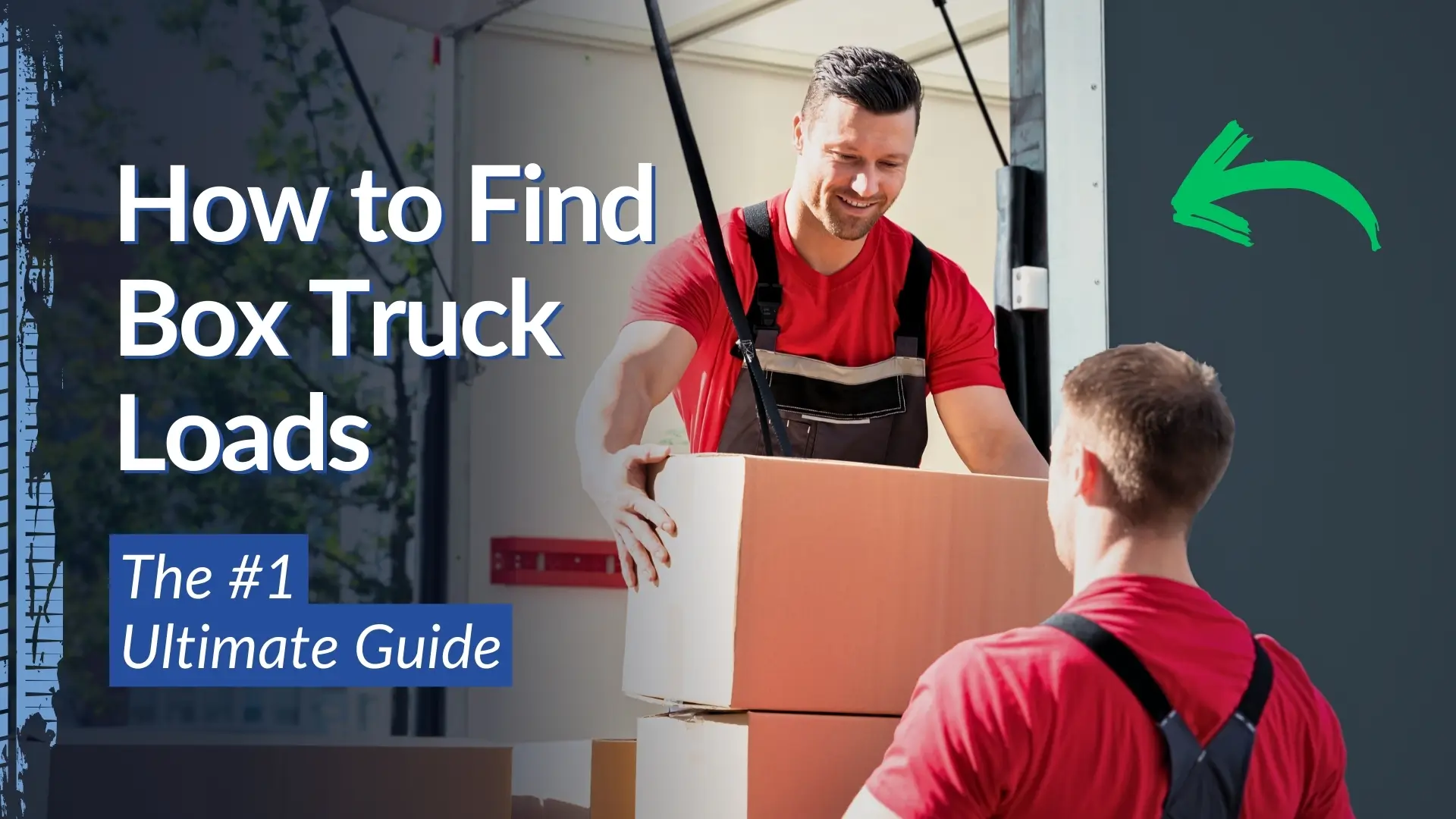
March 29, 2024
How to Find Box Truck Loads: The #1 Ultimate Guide

March 22, 2024
Buyer's Guide to Commercial Box Trucks: Box Truck Sizes and Weight Classes
.jpg)
March 15, 2024
A Day in The Life of a Trucker & Tips for Better Trucking Life
Back to topics

Join 100,000+ Drivers
- Sponsorship
- Thinking of Becoming a Truck Driver?
- Getting a CDL License
- Trucking Driving Jobs Guide
- Trucking Company Guide
- Trucker Life
- Paid CDL Training
- CDL Schools
- Professional Driving Skills + Knowledge
- Owner Operator
- Latest Articles
- Truck Driver Skills
The Pre-Trip Inspection: A Practical Guide For the Truck Driver
Updated February 24th, 2022
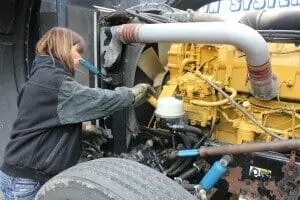
The pre-trip inspection is an integral part of every road trip for a trucker.
It’s probably the most disliked and most often overlooked part of the job of the professional truck driver in the trucking industry.
This inspection is meant to be a thorough check of the truck, trailer and load.
The check is to ensure that everything is in correct working order, prior to the truck and driver, departing on a trip.
Any damage or issues found during the pre-trip inspection which needs attention, must be addressed before departure.
CDL Test Pre-Trip Inspection
If you just came through the process of getting your CDL, you can breathe a sigh of relief.
You don’t have to check all 500 or so items that you had to memorize for the test every single day.
Out on the road, a thorough pre trip shouldn’t take more than 10 to 15 minutes.
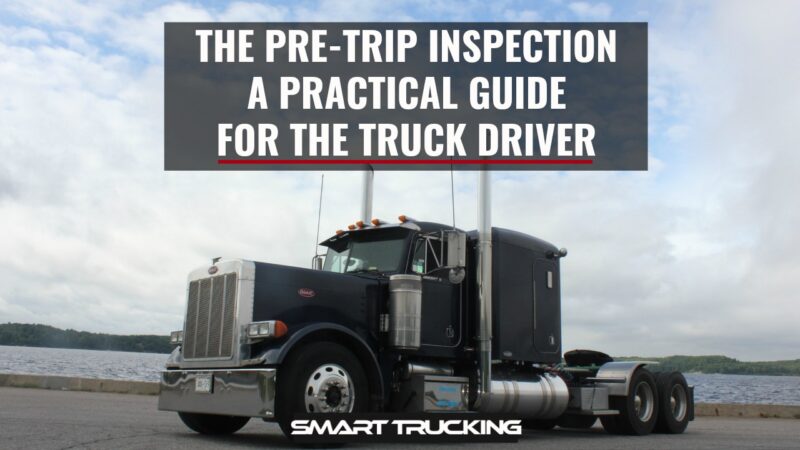
DVIRs – Daily Vehicle Inspection Report
According to federal law ( FMCSR Section 396.11 ), every day, a driver must submit a Daily Vehicle Inspection Report (DVIR) for each power unit he operates. Multiple trailers can go in one report.
DVIRs are either paper or electronic.
Not every trucking company (ahem) enforces this policy, so some truck drivers can go months or years without submitting a DVIR.
Minimum DOT Pre-Trip Inspection Requirements
- Service brakes including trailer brake connections
- Parking brake
- Steering mechanism
- Lighting devices and reflectors
- Windshield wipers
- Rear vision mirrors
- Coupling devices
- Wheels and rims
- Emergency equipment
Your trucking company’s DVIR might be more thorough.
This is a thorough Q&A on DVIRs which you can refer to.
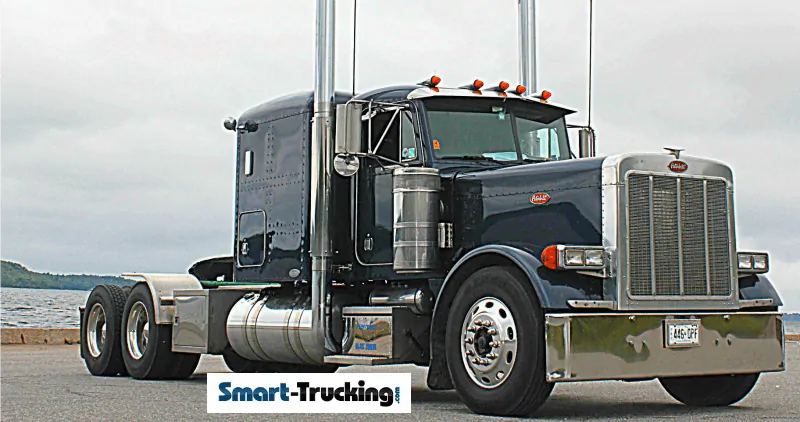
Inspecting a New Truck
When you are assigned a new truck (either daily or just once), there are a few additional things you need to check for on the pre-trip inspection.
Truck Compliance
- Cab card and book – This is a book containing the registration, inspection, permits, cab cards, IFTA paperwork, and any other important papers for the truck. Make sure it is in the truck and all the paperwork is up to date.
- Inspection sticker – This is outside the truck. Find it and make sure the truck is not overdue.
- IFTA stickers – These are the fuel tax compliance stickers. They are on both sides of the truck. Make sure the current year is displayed.
- Elog device – Most trucks are required to have a working elog device.
- Required permits – These are in the cab card book. The most common permits are Heavy Motor Vehicle Trip Permit (Oregon) and the Weight Distance Tax Permit (New Mexico).
- New York HUT sticker – This is usually on the front of your truck. It’s a type of permit.
- License plate – Make sure the license plates on the front and back of the truck match.
- FMCSA Safety Regulations and Hazardous Materials book – These will be given to you by your company. They must stay in your truck within arms reach from the driver’s seat.
- Paper logbook – If your e-log stops working, you must log your hours in a paper logbook, which must be kept in your truck.
- Medical card – You must keep your current medical card in your truck. Always have your CDL on you as well.
- Orange triangles – You must have 3 triangles for when you break down.
- Fire extinguisher – Must be charged and secured to the truck. No rolling around on the floor.
- Extra fuses – If your truck doesn’t use circuit breakers, you must have spare fuses.
- Load bars and/or straps
- Extra oil, coolant, and windshield washer fluid
- Line antifreeze and diesel anti-gel
- Chains and bungees
- Gladhand seals
- Hammer, wrench, wire cutters, cable cutters, knife with glass-breaker
The Class A Pre-Trip Inspection Process
Unless I have to bobtail to pick up my trailer, I inspect my truck and trailer together.
The best way to memorize a thorough pre trip is to do it the same way each time.
Your process will look different from mine, but as long as you are consistent, you will be less likely to miss anything.
I do the inspection first thing each morning as well as every time I swap trailers.
Paperwork and Trailer
- Check the paperwork. It should be the first thing checked when you get to your truck.
- Match the trailer number to your paperwork. If your trailer has a seal, make sure it matches too.
- Unsealed trailer. If your trailer does not have a seal, open it and confirm the product matches the bills. If you are picking up an empty trailer, open it and make sure it’s actually empty.
- Confirm your destination. Ensure the destination is the same as on your trip sheet or load assignment. If there is a discrepancy, call your dispatcher.
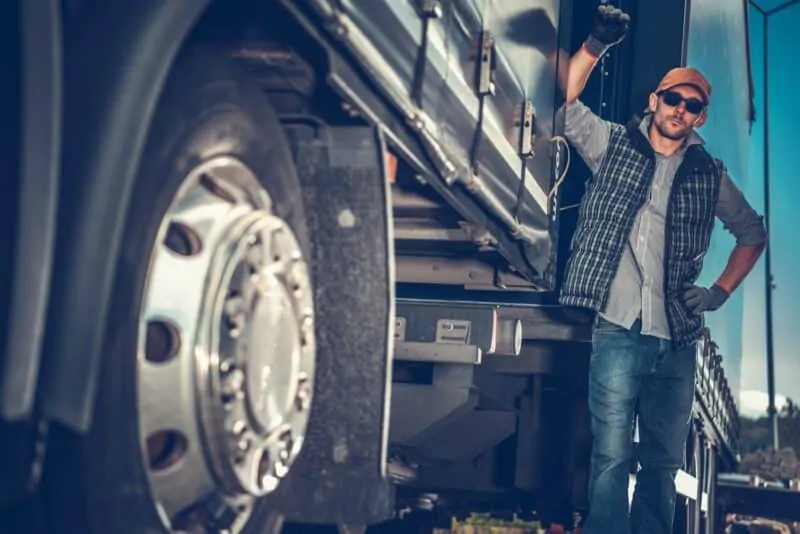
I personally like to start with checking under the hood of the rig. Not everyone does, but I do.
Under the Hood of the Truck
I walk around the front of the truck, making sure all the lights work. Then I open the hood.
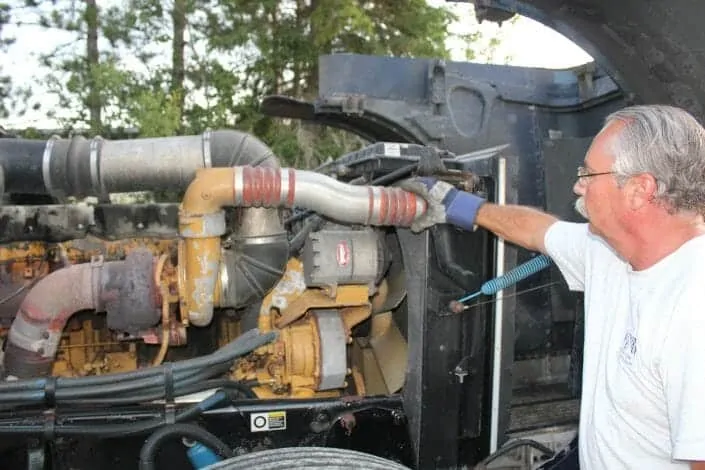
- Fluid levels – Check all fluids: coolant, oil, power steering fluid, and windshield washer fluid. Make sure caps are tight for the rad, oil filler, power steering fluid and the dip-stick is seated properly.
- Alternator, water pump, power steering pump –Make sure these are in good working order, and the belts are not worn or have too much slack.
- Observe at the engine block. Check for leaks, fluid running down the side of the engine. Check for wear, cracking or fraying. Inspect fan belts for proper tension and signs of wear.
- Hoses – Check all hoses for leaks, cracks, and tears.
- Wiring – Check wiring for wear.
- Steering linkage – Check linkage for worn or missing parts.
- Tires – Tires should be properly inflated and have decent tread. If there are flat spots on the tire, it needs to be replaced.
- Hub seal – Make sure it’s not leaking and wiped with oil if transparent.
- Brakes – Brake chambers should not be out of round and should be free of grease. Shoes should not be worn down too much.
- Slack adjusters – Pull slack adjuster. If it travels more than an inch, it needs to be adjusted.
- Suspension – Shocks should be in good condition, and not covered in grease or oil.
Back of the Truck
Next, I check the back of my truck because it’s easier to check this before hooking to a trailer.
- Tires – Tires should be properly inflated and have decent tread. If the tires have flat spots, the tire needs to be replaced.
- Suspension – Shocks and airbags should be in good condition, and not covered in grease or oil.
- Drive shaft – Driveshaft should be undamaged and free of grease. Make sure there is no debris in the u-joints.
- Frame – The frame should not have any welds and not cracked or significantly rusted.
- Fifth wheel – The fifth wheel should be properly greased and not broken.
- Fuel tanks – Fuel tanks should not be leaking.
- Stairs and catwalk – Stairs and catwalk should be free of debris and not broken.
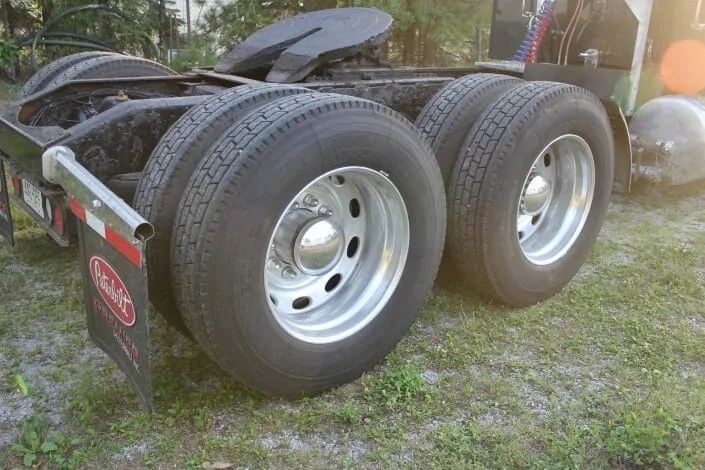
Tires should be checked with a tire gauge.
Tip . This is especially if you are slip seating. Tire thumpers aren’t very accurate. If you use a tire thumper, still check with a tire gauge from time to time.
Drives and tandems should be inflated to 100-110 psi and have a minimum tread or 2/32in. Steer tires should be inflated to 110-120 psi and have a minimum tread of 4/32in.
Tires under 50 psi should be replaced, as they can’t retain enough air pressure.
Flat spots can occur from dragging tandems in the winter or when trying to slide the tandems. Tires with flat spots should be replaced.
Check tires for damage, nails, and punctures.
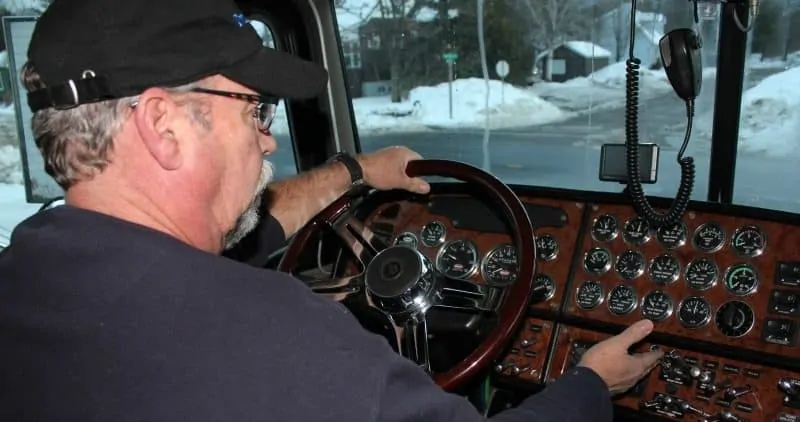
Next, I jump in my cab and start my truck.
- Gauges – Make sure air, oil, and water temperature gauges rise to normal levels.
- Mirrors – Adjust mirrors before moving your truck.
- Windshield wipers – Make sure they work and sit flat against the windshield.
- Horn – Make sure the city and air horns both work.
- Heat and A/C – Check to see if heat and/or air conditioning is working.
- Seat belt – Seat belt should not be frayed and should move freely.
Coupling and Air Lines
This is what could happen if you don’t do the tug test.
The pre-trip inspection is a pretty important thing to do.
Learn your pre-trip procedure and do it when required.

This is why you should always do a tug test when picking up a trailer. The passenger side of the front of the trailer is resting on the frame of the truck and NOT hooked up to the 5th wheel.

The front left corner of the trailer is supported by retracted landing gear only. (Not good!)
The truck driver in this photo (hopefully) learned how critical a pre-trip is. Don’t end up in a pickle like this guy.
Next, I hook up to my trailer.
- Tug test – I back under my trailer until I hear a click, and then immediately do a tug test.
A tug test tests both your coupling and your brakes. If you pull away from your trailer, you aren’t hooked properly.
If you pull your trailer with you, your trailer brakes are out of adjustment. Be absolutely sure to write it up and have it corrected before departure.
- 4 Ways + Headlights. I also turn on my four-way flashers and headlights.
- Airlines and pigtails – Next, hook up airlines and pigtails (electrical connection). Inspect to make sure they aren’t leaking or ripped.
- Visual check of Fifth wheel – Look at the fifth wheel arm under the trailer to make sure it is coupled. The arm should be in.
- Landing gear – Raise the landing gear and check for damage.
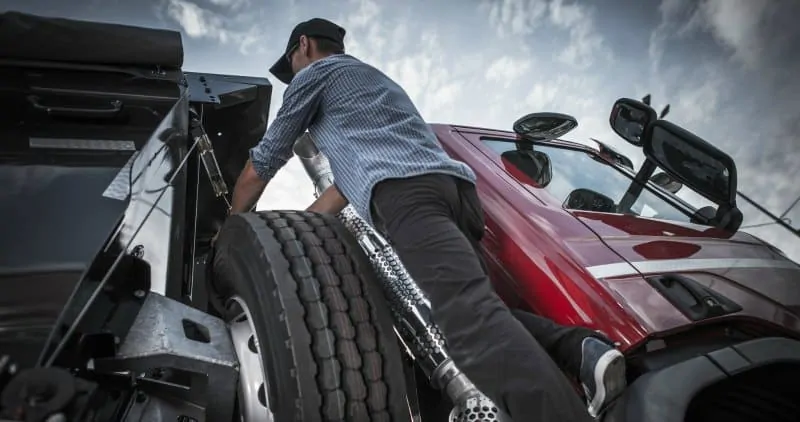
Next, I check the bulkhead (front of the trailer).
- Wall – Make sure the wall is not damaged.
- Inspection sticker – Check the DOT inspection sticker to make sure it’s not out of date.
- Registration paperwork – Check the front trailer box to make sure the registration is good.
- Reefer unit – If you are pulling a reefer, select the pre trip function on the unit and run it. It should be completed by the time you are finished your pre trip inspection.
Next step for the pre-trip inspection is to check the side of the trailer and the tandems.
- Lights – Lights should be on and flashing.
- Suspension – springs or airbags should be in good condition, and not covered in oil or grease.
- Tandem pins – Tandem pins should be locked in position, and slider arm should be in its cradle.
- Cables – Make sure the tandem cables aren’t dragging on the ground.
- Underbelly – Make sure there are no damaged beams under the trailer. Check the entire length.
- Mudflaps – Mud flaps should not be torn and hanging.

Back of Trailer
Next, I check the back of the trailer.
- Doors – Doors and hinges should not be damaged.
- Door latches – Doors should be closed and secured.
- Seal – Seal should be intact and match paperwork.
- DOT bumper – DOT bumper should not be damaged
- License plate – Check for the license plate. They tend to wear out and fall off.
Passenger Side
Next, I check the passenger side.
- Brakes – Brake chambers should not be out of round and should be free of grease.
- Suspension – Springs or airbags should be in good condition, and not covered in grease or oil.
- Mudflaps – Mud flaps should not be torn.
Ready to Roll
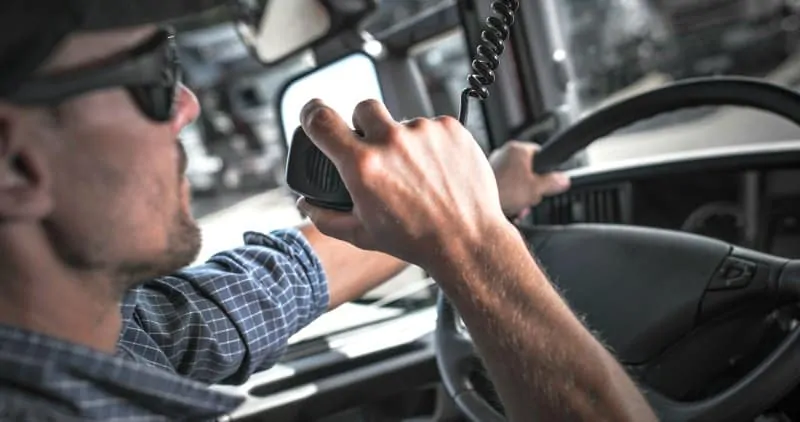
Finally, I jump in my truck and double check my paperwork and destination.
I release my air brakes, roll forward, and push the service brake.
If everything is good, I’m ready to roll.
Post-Trip Inspection
When I’m done for the day, and every time I swap trailers, I do a post-trip inspection. If I am swapping trailers, I do a pre-trip on the new trailer as well.
A post-trip includes:
- lowering the landing gear
- removing the airlines
- uncoupling, and walking around the trailer checking tires, lights, seal, and mudflaps
Then I finish my paperwork and go home.
Slip Seating
If you slip seat (meaning you are in a different truck each shift), your pre- trip check should be more thorough than if you are permanently assigned a truck.
This also applies to the first inspection after being assigned a truck.
Please be courteous and write up any problems or issues found, so the next driver of the vehicle doesn’t have to deal with it.
Side Note: Clean out your truck and throw away any trash. Common courtesy goes a long way in trucking, between drivers.
Pre-Trip Inspection F.A.Q.
Most breakdowns can be avoided with proper preventative measures, such as daily inspections.
Thorough inspections should be done at the start of each shift. Inspections of trailers should be done every time you swap trailers.
Each driver should do a thorough pre-trip every time they swap drivers.
It should take about 10-15 minutes to perform a pre trip inspection.
The DOT. Make sure you stay in compliance so you don’t end up with hefty fines and an out of service.
The best way to memorize your pre trip inspection routine, is to do it the same way every time. That way you’re less likely to miss something. If you have questions, ask your safety team at your company.
Fluids in the engine, engine hoses and wires, brakes and suspension, mudflaps, trailer registration and inspection paperwork, and license plates.
A Few Trip Planning Tips
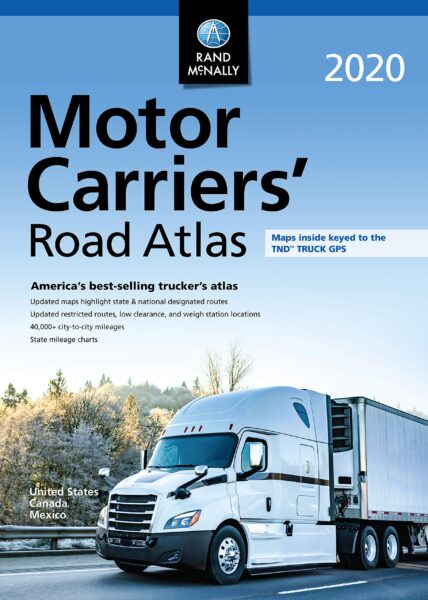
- Buy and learn to read a trucker’s atlas. It’s useful to plan routes and avoid restricted roads. I find this road atlas a necessity as a professional truck driver.
- Buy a decent trucking GPS , but don’t rely on it 100%. Use common sense.
- Don’t use the GPS in your elog device. It will put you in a lake.
Please note that minimum requirements for the inspection are established by the FMCSA.
But these may vary by state, trucking company, truck type, and trailer type.
It is your duty as a professional truck driver to perform a thorough pre-trip inspection before each trip and before you drive.
You’ll save yourself from headaches, fines and unnecessary accidents.
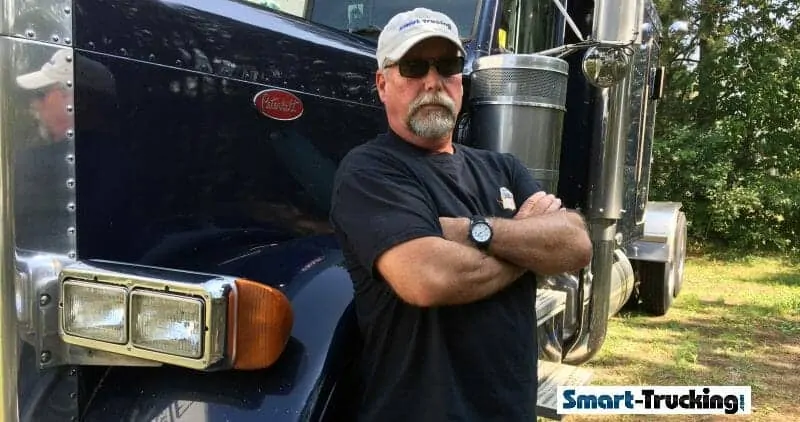
More Articles You May Like
- Trucking Terms – A Guide to Our Industry’s Lingo
- The 18 Wheeler – A Comprehensive Guide to Big Rigs
CDL Truck Driver Skills – Tips, Tricks + Knowledge to Kick Your CDL Skills Up a Notch!
- The D.O.T. Physical- A Guide For the Truck Driver
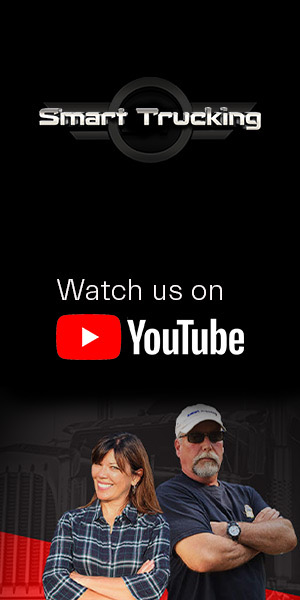
Everything You’ll Want To Know About Paid CDL Training
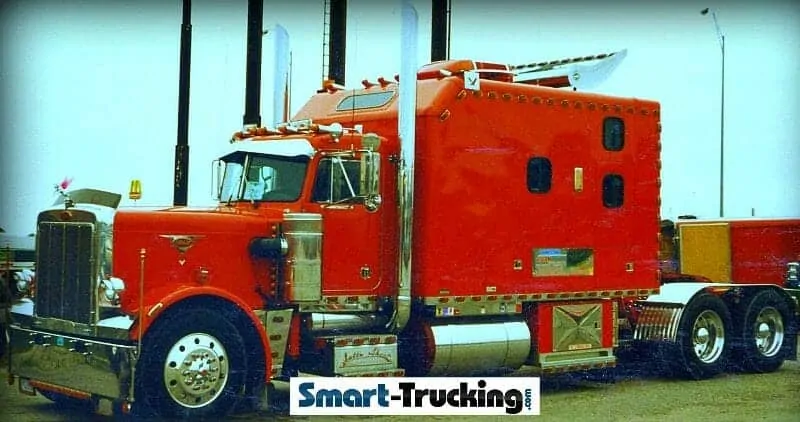
Custom Big Truck Sleepers Photo Gallery Collection
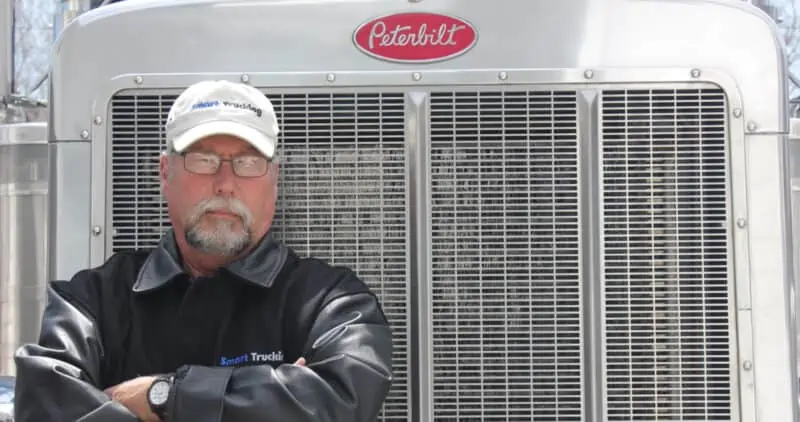
The Best Trucking Companies to Work For 2024 USA
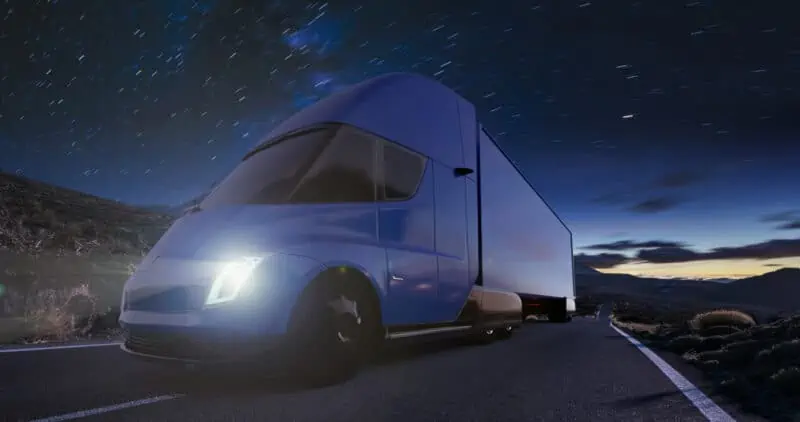
5 Best GPS For Truckers – A Professional Driver’s Guide
Twice a month we email you the best tips and new articles to help you better navigate the trucking industry..
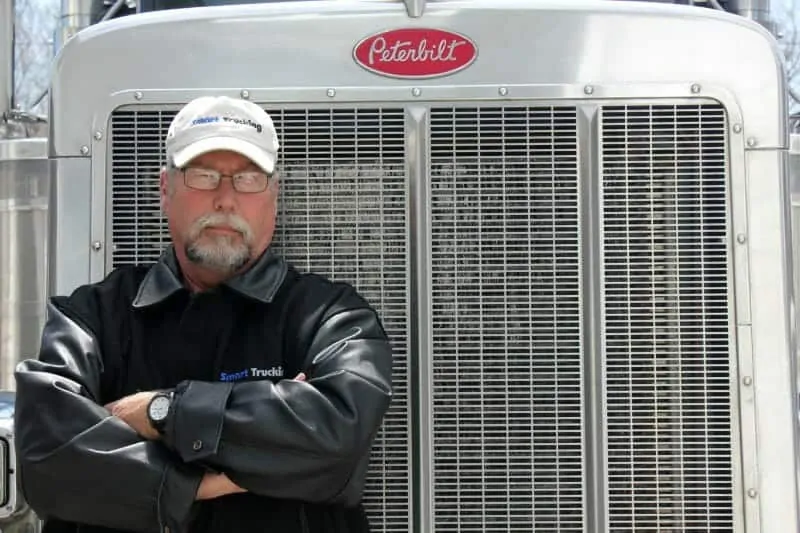
10 Truck Driving Safety Tips Every Professional Driver Should Follow
A veteran 40+ years truck driver shares 10 of the all time, tried and true truck driving safety tips ALL professional truckers should know AND follow! If every driver of EVERY vehicle on the road followed these safety tips, our roads would be SO much safer.
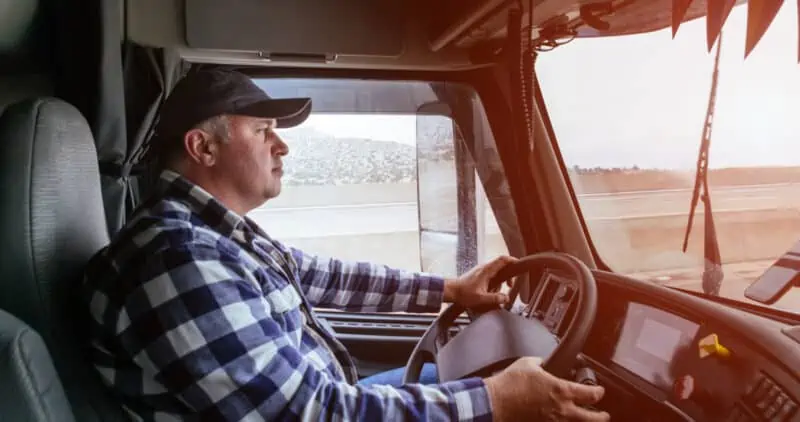
Trucker Tips Master Guide: Expert Advice From Experienced Truck Drivers
A collection of trucker tips from million milers and experienced drivers. These are gold nuggets for the new truck drivers!
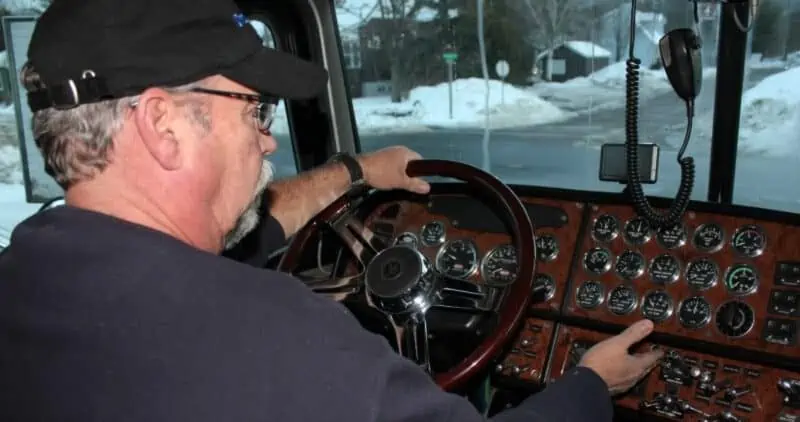
Instruction, clear advice, videos and photos for truck driver skills, maneuvers and information for all professional truck drivers.
A practical guide to paid CDL training programs. Recommended Company Sponsored Schools, Requirements, pros + cons, what to expect from company-sponsored cdl training programs.
Is a Career As a Department of Defense Truck Driver For You?
As a Department of Defense (D.O.D.) truck driver, your role is integral to the logistics and supply chain operations of […]
Navigating Fair Truck Driver Pay: Are You Earning Enough?
Ready to take control of your truck driver pay? Discover key factors impacting your earnings and ensure you’re compensated appropriately […]
The Best Tanker Trucking Companies to Work, U.S., 2024
Top Tanker Trucking Companies in the US To Work For Tanker work typically falls to the ‘better carriers’. Tanker carriers […]
Best Flatbed Trucking Companies, US, 2024: Our Top Picks
There are over 1 million truck drivers working for flatbed trucking companies in the U.S. trucking industry. However, not all […]
Best Trucking Companies For New Drivers in the U.S., 2024
For new drivers entering the trucking industry, diving into the right pool can make all the difference. The foundation of […]
Follow Smart Trucking
AI-powered applications
Top features

Get the most out of your equipment.
Get unparalleled visibility into the location, utilization, and health of your equipment, starting with the new compact and durable Asset Gateway Mini.
By industry
By company size

Heritage-Crystal Clean reduced compliance violations by 25%.
How a 1,000-vehicle fleet simplified compliance for its drivers and managers.
Technical resources

Physical Economy Outlook 2024
59% of physical economy leaders think rising costs are their biggest threat. Survey of 1,000 leaders uncovers the challenges physical operations leaders experienced over the last year and the opportunities ahead.
Get to know Motive

Empowering a culture of safety, efficiency, and sustainability
Our 2023 Impact Report highlights how we partner with our customers and invest in our people and our organization to drive sustainability and positive impact.
Talk to Sales or Support
+1 855-511-3529 Visit Help Center
- Blog »
- Tips for drivers
CDL pre-trip inspection checklist.
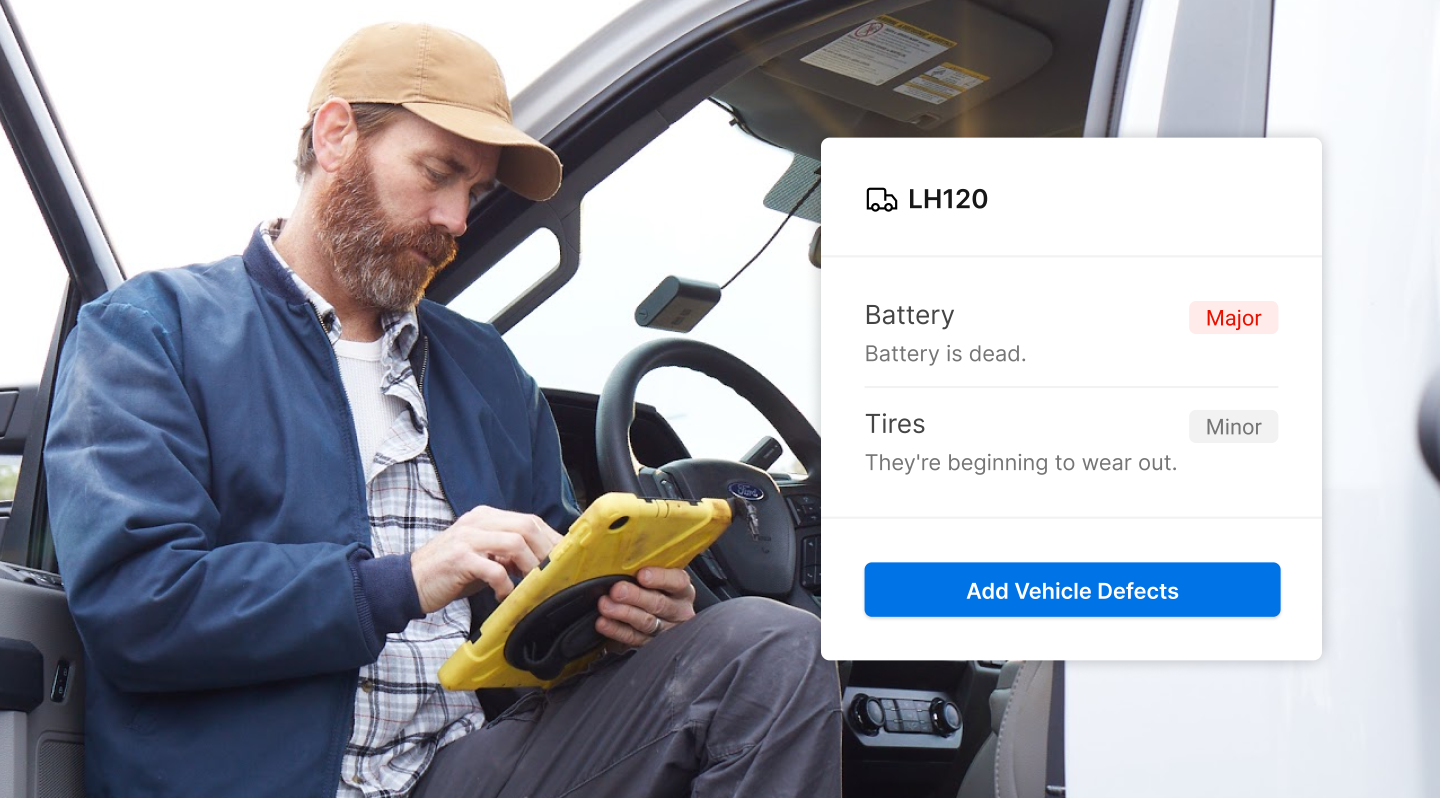
A commercial driver’s license (CDL) can put you behind the wheel of a tractor-trailer, a flatbed, or a tanker, among other non-passenger vehicles. Before you hit the road though, you’ll need to complete a CDL pre-trip inspection checklist. By inspecting the commercial vehicle beforehand, you can head out on your route knowing you’ve confirmed major systems and parts are road ready. Recognizing road safety is always a fleet priority . This article provides a comprehensive guide to the CDL pre-trip inspection checklist.
What is a CDL pre-trip inspection checklist?
A CDL pre-trip inspection checklist systemizes the driver’s vehicle inspection to ensure care and consistency. While a pre-trip inspection would be a best practice no matter what, the Federal Motor Carrier Safety Administration (FMCSA) requires these checks for commercial vehicles. Part 396.3 (a) calls on every motor carrier to “systematically inspect, repair, and maintain, or cause to be systematically inspected, repaired, and maintained, all motor vehicles subject to its control.”
The fleet also has to keep formal records of their vehicle checks. So, drivers typically follow a CDL pre-trip checklist and record their findings in the driver vehicle inspection report, or DVIR , confirming the commercial motor vehicle (CMV) inspection is complete.
A CDL A pre-trip inspection checklist requires drivers to inspect many different parts and system including:
- Vehicle lights
- Tires, wheels, and rims
- Windshield wipers
- Emergency equipment
Different motor carriers may add their own expectations to the CDL pre-trip checklist. But they would be adding particular items to check, not doing away with the pre-trip inspection. After all, non-compliance with the federal pre-trip inspection requirements can earn hefty fines and lead to the loss of certifications and licenses.
The Class A CDL pre-trip inspection checklist is important enough that drivers testing for their license are expected to do the pre-trip inspection as part of their examination. Inspection requirements can vary by state. There’s also a Class B CDL pre-trip inspection list.
Why is the CDL pre-trip inspection checklist important?
Compliance isn’t the only reason following the CDL pre-trip inspection checklist is important. The federal requirement is in place, after all, to ensure commercial vehicles on the road are safe to drive.
With continued investment into critical infrastructure over the last 20 years, the percentage of roads in good condition has climbed since 2000. Yet the United States still has hazardous roads. In fact, “from 2000 to 2020, the share of major roadways in poor condition has remained fairly steady, rising from 11.8% to 13.8% over the course of 20 years.”
This makes keeping commercial vehicles in top shape all the more important to safety and efficiency. A CDL pre-trip checklist helps improve fleet safety by avoiding drivers going out on the road in vehicles that are not fit for duty. Taking a truck out on the road with an unsecured load, damaged brakes, disconnected wiring, or another issue could lead to drivers hurting themselves or somebody else.
Fleet vehicle inspections can also help keep drivers on the road. Identifying issues in advance can help avoid major problems that mean downtime and costly repairs. Plus, if the Department of Transportation (DOT) inspects the vehicle and finds something that the driver missed, they can put that vehicle out of service for longer. DOT violations can also lead to fines and hurt your CSA scores . A decrease in your CSA scores can lose your fleet business and cause your insurance premiums to go up too.
How to perform a CDL pre-trip inspection
Although there is no specific time limit, a thorough CDL pre-trip inspection usually takes 15 to 30 minutes. This pre-trip starts at the front of the truck, but you can take the steps in this CDL pre-trip checklist and make them your own.
Front of the truck
Verify lights are clean, securely mounted, the right color, and working. Make sure the truck isn’t leaning. Confirm there are no leaks under the engine compartment.
Engine compartment
Check critical fluid levels. This includes power steering, coolant, windshield washer fluid, and engine oil. Inspect reservoirs, tanks, and hoses for any leaks, splits, or cuts. Ensure the hoses for the water pump, coolant, oil, and power steering are all properly connected and securely mounted. Check the air compressor is well secured. Inspect to make sure the belts on the alternator, pumps, and compressor are secure as well. They should have no more than 1/2″ to 3/4″ of play with no cuts or splits.
Front of the truck/tractor
Inspect the steering shaft and gear box to see they’re properly mounted to the frame and that there are no cracks or breaks. Check gear box hoses for leaks. Look for excessive play in the steering belt, secure connections. Check connections and look for leaks on pitman arm, drag link, and upper/lower control arms and tie rod. Move on to the spring mounts, leaf springs, and U-bolts to confirm they are not cracked or broken and are securely mounted. Do the same with shock absorber but also look for visible leaks and ensure the rubber bushings don’t have dry rot. Check the rubber of the airbag.
Check the hose, chamber, drum, pads and slack adjuster to confirm secure mountings and no leaks. Look out also for any breaks, splits, or cuts. Verify slack adjuster push rod has no more than 1″ of play and is at a 90° angle to the brake chamber. Check the brake drum has no bluing from excessive heat. Ensure brake pads have a minimum thickness of 1/4”.
Wheels/tires
Check tires for cuts, bulges, and abrasions on your tires. Confirm tire tread depth and inflation levels. Check All lug nuts are accounted for and in good condition. Ensure valve stem is properly secured and capped. Look out for unauthorized or illegal welds on wheel rims. Check tires are properly spaced if your tractor/trailer has duals. Confirm the hub seal/axle seal is not loose and has no visible leaks.
Rear of truck
Look at the frame to ensure nothing is broken. Check for unauthorized welds. Confirm the catwalk and steps are properly mounted and kept clear. Ensure the drive shaft is free of debris with unbroken and untwisted U-joints. Verify the exhaust system is secure and look for exterior soot, which could indicate a leak. Make sure mudflaps are also secured at the right height.
Coupling area
Check that the fifth wheel platform, apron, and kingpin are secure, not cracked, bent, or broken. Look for any unauthorized or illegal welds. Confirm skid plate is properly greased. Verify release arm, locking jaw, and slide locking pin are fully locked. See that mounting bolts are tight and none are missing. Ensure glad hands have seals in good condition with no signs of rot or leaks. Secure electric lines with safety latches in place. Check air connector is secure on both ends without cuts or abrasions.
Verify that there are no holes in the trailer’s front, sides, or floor and that all rivets are present. See that DOT tape is properly secured and not dirty. Check that all hardware is present on an untwisted, unbroken frame and that cross members are securely mounted with none missing. Ensure lights are clean, working, and not loose. Confirm landing gear is raised, securely mounted, with an operational handle. Check air lines are securely mounted, above ground, with no audible leaks. Verify tandem slide and release arm are properly mounted and locked.
Truck exterior
Make sure that the truck steps are mounted and secure. Ensure the fuel cap is tight and the tank is not leaking. Demonstrate that the doors latch properly with hinges intact. Ensure mirrors are unbroken and securely attached. Check all the lights and reflectors are working too. This means inspecting the running lights, high beams/low beams, turn signals, hazards, brake lights, license plate lights, and reflector tapes. If driving a hazardous load , ensure you have the proper hazmat placards securely affixed.
Check to ensure your seat belt adjusts and latches properly and that there are no rips or frays. Confirm the shifting distance, room for the clutch, and that parking brake is on. Verify the steering wheel is secure and that the foot pedals are clear of obstruction. When the vehicle is on, look for the ABS light to come on and off. Make sure the windshield wipers, heat and defrost, gauges, and horns are working. Pump the brake pedal several times then apply pressure to the pedal and hold for five seconds to ensure the pedal does not move. For air brakes, confirm applied pressure, warning lights and buzzers, and valve pop-out are all working. Look for three reflective triangles , spare fuses or circuit breakers, and a properly charged and rated fire extinguisher with its pin in place.
Common issues found during pre-trip inspections
While completing a CDL pre-trip list, drivers may encounter any of these common problems. This section identifies common issues, how to address them, and how to prevent future problems too.
Truck is leaning
Using the 3L’s you might see the truck leaning to one side. This could be a suspension problem or indicate low tire pressure.
Fix it by first checking the tire pressure and inflating tires. If that doesn’t address the problem, check the suspension. Driving a vehicle when there is a problem with the suspension, springs, shocks, or struts can cause severe damage to the vehicle.
Broken lights/warning lights
If you detect an exterior light is cracked or broken, fix it before going out on the road. If a light from the on-board diagnostic system comes on during inspection, e.g., “check engine” or “service engine soon,” address that warning as you’ll fail a roadside inspection if that light comes on.
Gas cap missing
Damaged or missing gas caps are a common reason for failed inspections on the road. Don’t set out on your route without replacing the gas cap.
Worn tire tread
Unacceptable or worn tire treads or knots or bulges in tires can also lead to failed roadside inspections. Don’t risk going on your route with substandard tires.
How to prevent future CDL pre-trip list problems
An eDVIR or electronic driver vehicle inspection report allows you to record, compile, and store pre-trip and post-trip information on electronic devices such as computers, smartphones, and tablets. This helps motor carriers and fleets to have a centralized record of inspection history, allowing authorized users to monitor progress, pull reports quickly, and promptly address driver, vehicle, or equipment issues.
Using an eDVIR , you can get out on the road faster with the convenience and accuracy of using a smartphone or tablet to record your data while ensuring your vehicle is safe for operations. Drivers can even take and upload photos to record details and communicate with fleet supervisors for quick troubleshooting.
Making pre-trip inspection checklists easier
CDL pre-trip inspection checklists help systemize the driver’s check of their vehicle before going out on the road. This enhances driver safety and can help reduce accidents. Consistently inspecting fleet vehicles also helps simplify fleet maintenance and avoids failed DOT inspections and reduced CSA scores.
Pre-trip checks are part of the day to day for drivers. Motive’s customizable eDVIR technology simplifies the reporting. Drivers can assess vehicle parts against a built-in checklist in the Motive Driver app, indicate the severity of the issue, and upload photos. Fleet managers get pre-trip inspection reports in real time. Plus, the technology provides advanced reports to help managers analyze health and maintenance trends for all fleet vehicles.
Ensure smooth fleet operations with Motive’s fleet safety software. Learn more today. Contact us to request a free demo.
Want to know more about commercial vehicle driving safety? Check out these tips .
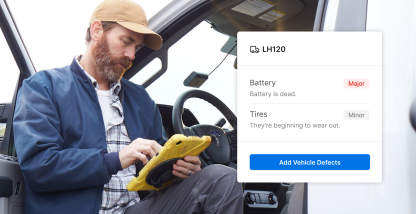
What is paid CDL training? What truckers need to know.
How to save gas while driving commercial vehicles..

How to get your commercial driver’s license in California.
How to spec your fleet vehicles to maximize fuel mileage., fitness tips for truck drivers: how to stay in shape., stay updated.
Subscribe to get the latest news, industry trends, blog posts, and updates.
Please enter a valid email address
Thank you for subscribing!
You will be the first one to receive the latest updates and announcements..
Complete CDL Pre-Trip Inspection Checklists for Class A and Class B Drivers
Your fleet is loaded, and the fuel tanks are full – you’re ready to move. Or are you?
If you haven’t completed a pre-trip inspection checklist, you might not be.
The Department of Transportation (DOT) requires all drivers holding a commercial driver’s license (CDL) to complete a pre-trip DOT inspection checklist before operating a commercial vehicle. Usually taking about 10-15 minutes, this inspection checks essential systems such as brakes and steering, as well as tires, mirrors, and emergency equipment.
So how can drivers know what to check? In this article, we’ll run down the DOT requirements for pre-trip inspection checklists, along with key differences between Class A and Class B inspections and even some useful tools that can help make the job easier.
What is a pre-trip inspection checklist?
A pre-trip inspection checklist is a list of items that CDL holders need to review before operating their vehicles. As you may have guessed, this process is known as a pre-trip inspection .
What is a pre-trip inspection?
Pre-trip inspections aren’t just an annoying routine – they’re an important and necessary safety measure that helps ensure that commercial vehicles are up to fleet safety operation standards .
While the scope and contents of a pre-trip inspection checklist vary according to the type of commercial vehicle and its use, you can complete most inspections in about 10-15 minutes. Checklist items generally include assessing the operational condition of anything the driver and vehicle need to operate the vehicle safely . This usually includes things like an air brake check, along with checking lights, tire pressure, couplings, and so on.
Drivers must also record their inspection results in a driver vehicle inspection report (DVIR), which is usually automated (or at least streamlined) in companies with established fleet management tools. Periodic inspection requirements require additional pre-trip inspections every 24 hours of continuous use or whenever the driver changes vehicles.
It may seem like a lot to review, but most of it boils down to common sense. Before you start crawling under the nearest truck, however, you may want to see whether you have to perform a pre-trip inspection in the first place!
Who needs to complete a pre-trip inspection?
Pre-trip inspections are mandatory for both Class A and Class B commercial driver’s license (CDL) holders.
If you’re a CDL holder, you probably already know which Class you fall into. But just in case, here’s a quick refresher on the types and weights of vehicles that different classes of CDL holders can operate.
- The Class A CDL applies to commercial vehicles weighing at least 26,001 pounds that can tow at least 10,000 pounds. This usually encompasses most towing commercial vehicles such as big rigs, tractor-trailers , and flatbeds.
- The Class B CDL applies to commercial vehicles weighing at least 26,001 pounds that can tow no more than 10,000 pounds. This usually encompasses most non-towing commercial vehicles, such as passenger buses, garbage trucks, and delivery trucks.
While there is also a Class C CDL, this usually extends to specialty vehicles not found under either Class A or Class B (such as hazardous waste transport). However, since their detailed inspection procedures are highly specific and beyond the scope of this article, we won’t cover them here.
But what’s involved in Class A and Class B inspections, and how can they differ?
Class A vs. Class B pre-trip inspections
While Class A and Class B vehicles share many of the same detailed inspection procedures (every commercial vehicle has brake lights, after all), each class and vehicle type has its own inspection procedures.
- Class A and Class B commercial vehicles share many common inspection items, such as front and rear suspension, brake lights, minimum brake pad thickness, oil level, etc. These are usually items that apply to any type of road vehicle.
- Class A inspection items are usually those related to towing systems in commercial vehicles, such as the trailer parking brake, coupling areas, etc. These inspection standards usually extend to the trailer, flatbed, or any other object that the truck is towing.
- Class B inspection items are usually those related to non-towing commercial vehicles. As this is a very broad category, some Class B vehicles may not require any additional inspections, while others may have several specific systems to inspect. In the case of the latter, these are usually items specific to the vehicle itself, such as checking for broken seat frames in passenger areas of a bus.
Of course, there’s much more to each pre-trip vehicle inspection than the handful of key differences we’ve listed here. In the next section, we’ll run down the pre-trip inspection process that applies to nearly every commercial vehicle and then detail more class-specific motor vehicle safety inspections.
CDL pre-trip inspection checklist
The standard CDL pre-trip DOT inspection checklist includes everything a commercial motor vehicle needs to navigate the road safely.
These are generally suspension- and engine-related items that would just as well apply to a regular car. As a general rule, a commercial pre-trip inspection test almost always includes the following motor vehicle safety inspections.
Brake system
There’s nothing more important than your vehicle’s air brakes. Note that the following air brake tests apply to both tractor brakes and trailer brakes on Class A commercial vehicles.
- Brake linings and brake pads: Brake pads should be no less than the minimum thickness of one-quarter inch (¼”). Also, be sure to check linings for oil and debris.
- Brake chamber: The brake chamber should be completely sealed with no audible air leaks.
- Air brake hose: No air should leak from the brake hose, and the line should be properly mounted and free of cuts or splits.
- Brake drum: Should not be blue from excessive heat.
- Hand brake: Push rods should have no more than one inch (1”) of play in either direction and stand up 90 degrees when pulled.
Depending on the vehicle, these items are usually checked with a 9-step, 7-step, or 5-step brake test. These tests usually involve pressing the brake pedal, service brake, hand brake, or foot brake under various conditions and seeing whether air pressure recovers to the proper level in time (see your vehicle’s operating guide).
For example, drivers can check for low air pressure by pressing the brake pedal to fan off the pressure. If repeatedly pressing the brake pedal results in a low pressure buzzer or light indicator, the brake system will require repair.
Engine compartment
Engine compartment inspection items include:
- Fluids: The coolant hose, power steering hose, and any tanks or reservoirs should all be securely mounted and have no leaks. Similarly, a dipstick should indicate that all fluid levels (including oil level and coolant level) are at their proper levels.
- Belts: All belts for compressors, pumps, and alternators should have no cracks or frays and give no more than one-half of an inch (½”) of play.
- Air compressor: Should be securely mounted and functional with no cracks or leaks.
- Water pump: Pump hoses must be properly connected with no leaks.
- Alternator: Wires and belts must be properly connected.
Front of vehicle
Front-of-vehicle inspection items usually include steering equipment such as:
- Steering column or steering shaft: The steering column should be straight and unbroken.
- Steering box: The steering gearbox should be intact, and all connected hoses should be securely mounted with no power steering fluid leaks.
- Tie rod and control arms: Both should be straight.
- Drag link: The rubber should be greased and uncracked.
- Pitman arm: All cotter pins and caste nuts are present, secure, and tight.
Front suspension
Front suspension inspection items include springs, spring mounts, shocks, and suspension airbags.
- Spring mounts and spring hangers: Spring mounts should hold spring hangers securely in place with no signs of wear, cracks, or breakage.
- Leaf springs: Should be secured to hangers with no cracks or breakage.
- Shock absorbers: Should have no leaks, splits, or dry rot in the rubber. Leaks are typically located where the top and bottom pieces overlap.
- U-bolts: Should all be securely fastened around the spring and axle.
Rear of vehicle
The rear of tractor or truck inspection items include the following.
- Driveshaft: Should be straight with unbroken U-joints.
- Exhaust: Should be free of rust with no leaks or excessive soot.
- Frame: Structurally sound with no damages or unauthorized repairs/welds.
- Steps: Structurally sound and mounted properly.
- Mud Flaps: Should be clean, unbroken, and secured at the right height.
Wheels and tires
Wheel and tire inspections check for both proper inflation and overall tire condition, specifically tread depth. Note that this also extends to trailers on Class A vehicles.
- Drive and steer tires: Tire tread should be even with a minimum tread depth of 2/32” on drive tires and a minimum tread depth of 4/32” on steering axle tires. Use an air pressure gauge to check inflation levels against manufacturer inflation levels. Treads and sidewalls should be free of cracks, bulges, and abrasions.
- Wheel rims: No unauthorized repairs or illegal welds.
- Hub seal and axle seals: Should show the axle and hub seal intact with no visible leaks or play.
- Dual spacing: Any dual tires must have enough spacing between them.
- Lug bolt holes: All lug bolt holes should have all lug bolts and lug nuts.
- Valve stem: No audible air leaks.
Lights and reflectors
Light and reflector inspections include everything from running lights to DOT tape and 4-way emergency flashers.
- High and low beams: Ensure both are functional on all forward lights.
- Turn signals: Make sure all are functional for both tractor and trailer.
- Brake lights: Make sure all are functional for both tractor and trailer.
- Running lights and license plate lights: Walk around the truck and make sure all are on.
- 4-way emergency flasher function: Walk around the truck to make sure the 4-way flasher rear and front lights are fully operational.
- Reflector tape and DOT tape: All DOT tape and reflector tape should be clean with no signs of excessive wear.
Driver door and fuel tanks
Cab doors and fuel tanks are often located in the same area on commercial vehicles. Be sure to check the following:
- Door and door hinges: Should be intact and latch completely. The rubber door seal should be clean and uncracked.
- External mirrors and mirror brackets: All external mirrors should be firmly attached to their mirror brackets. External mirrors should also be clean and uncracked. Also, be sure to adjust external mirrors and mirror brackets to provide an adequate rear view.
- Steps: Should be securely mounted and able to support the weight.
- Fuel tank: No leaks, with cap and seal unbroken and intact.
In-cab items
Cab inspection usually covers the following items:
- Steering wheel: Fully attached to steering column.
- Gauges: Check that air gauges, oil pressure gauges, and any other gauges for operation function normally within their operating range. Air pressure gauges should build pressure to the governor cut out during an applied pressure test.
- Warning lights: Lights should show clearly for any lighting indicators, such as ABS lights or oil pressure indicators.
- Windshield: Cracks beyond one inch (1”) are not permitted. Windshield wipers should be clean and work properly, and the truck should have enough windshield washer fluid.
- Seat belt: Should fasten securely.
- City horn and air horns: Both air and city horn should sound properly.
- Heater and defroster: Should heat and function properly.
Special checks for Class A and Class B inspections
As we mentioned earlier, a Class A pre-trip truck inspection will usually have different periodic inspection requirements than, say, a Class B pre-trip school bus inspection.
While periodic inspection requirements ultimately come down to the exact type of vehicle (a Class B garbage truck, for example, may require additional inspections for its armature and compactor), the main differences usually come down to trailers vs. passenger areas .
- Trailers share many of the same inspection checklist items as the tractor, specifically the wheels and tires, suspension, and rear of trailer lights and reflectors. Also, make sure that the landing gear is not broken and can be fully raised.
- Coupling area inspections include checking air connectors, electrical lines, and nearby glad hands. All mounting equipment, such as the fifth-wheel plate, kingpin, mounting bolts, skid plate, release arm, and locking jaw and pins, should be present, secure, and in good condition.
- Rear of truck suspension inspections share many of the same items as those of front inspections but with special attention paid to the torque arm (or radius rod), which should be mounted securely with intact brushings.
- Passenger items such as seating, passenger doors, and any wheelchair lifts should all be secure and in working order. Emergency exits should also be clearly labeled and sound an alarm when opened.
- School bus items include all of the passenger items listed above, with the addition of checking student loading lights, stop arm, student rear-view mirror, and a recent first aid and body fluid cleanup kit.
Pre-trip inspections made easy with CalAmp
With fleet management software from CalAmp, you can spend less time filling out pre-trip inspection reports and more time on the road. Request a demo today to see just how easy it is to use CalAmp’s pre-trip inspection tools!
Recent Related Stories
Connect with us.
Prime’s Guide to Pre-Trip Inspections
Tractor-trailers can weigh up to 80,000 lb . if you count the semi, trailer and cargo. Operating a heavy tractor-trailer can be dangerous, so drivers undergo extensive training to earn their CDLs and start their careers.
Whether studying for your CDL test or heading to your next customer, pre-trip inspections help you catch problems with your vehicle or trailer. Unchecked issues can lead to accidents or extensive repairs.
Do you know how to perform a pre-trip inspection? Need a quick refresher? Follow our guide to pre-trip inspections to learn the basics. Reach out to our Safety Department for more in-depth information.
Use these quick links to jump to sections of the article:
- The Engine Inspection
- Driver Door Area & Tires
- Trailer Pre-Trip Inspection
Lights & Reflectors
In-cab pre-trip inspection , large truck crash statistics .
Knowing how to operate a semi-truck safely in various conditions is imperative for drivers. In 2019, there were 510,000 large truck crashes, according to FMCSA’s 2021 Pocket Guide to Large Truck and Bus Statistics .
Of these crashes, 4,479 were fatal, and 114,000 were injury crashes involving large trucks. Most fatal large truck crashes involved those weighing more than 33,000 lb.
Accidents happen. Drivers can mitigate their risk of an accident by being responsible behind the wheel , following federal regulations and performing pre- and post-trip inspections.
Your Pre-Trip Inspection Checklist
Drivers must provide a vehicle inspection report at the end of each day. Vehicle inspection reports list any issues that could affect the vehicle’s operation and safety. Inspecting vehicles before and after each trip helps catch problems and keep drivers safe.
At a minimum, each report covers the following parts of a vehicle :
- Coupling devices
- Emergency equipment
- Lights and reflectors
- Parking brakes
- Service brakes
- Steering mechanism
- Tires and rims
- Windshield wipers
Pre-trip inspections take around 15 to 20 minutes. You’ll examine your truck and trailer to ensure it’s ready for the trip.
Before every haul, you should check that you have your license, registration, medical card, updated inspection sticker and FMCSA Safety Regulation manual. If you’re picking up a trailer, always make sure the trailer number matches the number listed on your assignment.
Follow these steps to inspect your tractor-trailer, and watch our video on Prime’s pre-trip inspections . Chock your tires before you begin, so the vehicle doesn’t roll or slip.
Under the Hood: Examining the Engine
Start your pre-trip inspection by looking at the engine. Lower the gear guard so you can open the hood. Remove pins and unlatch the hood to do so. Once the hood is open, step back and look underneath the truck to see if there are any leaks.
Passenger Side
On the passenger side, make sure that your general hoses and alternator are free of cuts, abrasions or cracks. Hoses should be sufficiently secured, exhibiting no signs of leaks.
Driver’s Side
Walk around to the driver’s side and conduct a similar examination. Look at the parts listed below for signs of wear, abrasions and leaks. Your coolant and oil levels should be filled to the manufacturer’s specifications. Keep an eye out for fraying belts, improperly secured parts, and missing castle nuts and bolts.
- Air compressor
- Belt-driven water pump
- Coolant reservoir
- Gearbox and hoses
- General hoses
- Power steering fluid
- Power steering pump
- Shock absorber
- Spring hangers and arm
- Steering linkage
Check Your Brake System
Drivers must check the brake hose, brake chamber and slack adjuster. When pulled by hand, the push rod should not move more than 1” with the brakes released.
Your brake line should be free of debris and oil, and the hose material shouldn’t be worn too thin.
Outside Driver Door Area & Tires
If the engine looks good, inspect the outside of the truck.
- Check your mirror on the driver’s side to ensure it is clean and firmly mounted to the vehicle.
- Open the driver’s door, and examine the door’s seals and hinges for cracks or dry rot.
- The fuel cap should be on tight, and the fuel seal should not leak.
- Ensure that the catwalk and steps at the back are clear of any objects or debris.
In addition to the steps above, drivers should look at the following parts for damage, wear or debris buildup:
- Brake hose, chamber, lining and drum
- Drive shaft
- Frame and cross members
- U-joints and bolts
Check Your Tires (All of Them!)
The tires on your tractor-trailer should have a tread depth of no less than 0.125” and be aired according to the manufacturer’s standards. You can check the air pressure with a gauge and adjust it based on your load and the temperature .
The rims shouldn’t be bent or broken, and there shouldn’t be cracks around the bolt holes. Behind the tire, the mud flap should not be tattered or loosely attached to the vehicle. There should be space between the mud flap and the tire.
Trailer Pre-Trip Inspection
Is the truck good to go? Check! Now it’s time to inspect the trailer. Walk around the trailer and examine it for cracks, abrasions or broken parts.
- Brake hose, lining and chamber
- Frame and cross members
- Shock absorbers
You’ll also want to check that:
- The landing gear is fully-raised with the crank handle secure in its cradle. The landing gear and mud flap should be a proper distance apart.
- The tandem relief’s handle and locking pins are in the fully-locked position.
- The slack adjuster and push rod don’t move more than 1” when pulled by hand.
The back doors of the trailer should latch properly. The trailer’s lock rods and hinges must be intact and not bent. Your trailer should also have door chains for safety when loading and unloading.
Coupling: Back of Tractor, Front of Trailer
A driver’s next step is to examine where the tractor and trailer connect.
- Electric line — Ensure there are no exposed wires. The line should be secure.
- Air line — Your air line should be secured at both ends and not leaking.
- Gladhands — Check for worn or rotted seals on gladhand couplings. Make sure there are no leaks in the gladhands connected to the trailer’s air brakes.
- Trailer apron — No gap should exist between the apron and the skid plate. The skid plate should be lubed.
You should also check the kingpins, mounting bolts, and the sliding fifth wheel and locking pin.
Refrigerated Trailer Inspections
When you inspect one of Prime’s refrigerated trailers , you start by selecting the “pre-trip” option on the trailer’s display. It will take the reefer 10 to 15 minutes to complete a self-inspection and notify you of anything in need of adjustment or repair.
While the reefer’s self-test runs, you should look for any signs of damage on the bottom rail, top rail and sides of the trailer. Reefers are insulated. Drivers need to examine the trailer for cracks and exposed insulation.
You don’t want to drive off without working lights. The lights on your truck and trailer should be securely in place, not cracked and amber in color.
- Clearance lights
- Marker lights
- Headlights
- Tail lights
- Reflective tape on trailer and mud flaps
Once you’ve checked that the lights and reflectors are intact, you should test your lights and turn signals. Climb into your cab and turn the following lights and signals on:
- Left turn signal
- Right turn signal
- Four-way flashers
- Brake lights
Inside your cab, you’ll check that your seat belt latches and is not too worn. Next, check that you have a fire extinguisher that’s charged. Ensure your cab has three reflective triangles under the bunk area and electrical fuses in the glove box.
Once you’ve reviewed your safety gear, adjust your mirrors, start the engine and check the dashboard’s instrument panel:
- Oil pressure — It should be rising as the engine runs.
- Voltmeter — It should show the alternator charging between 13 and 14 volts.
- Air pressure — It should be around 120 to 125 psi.
While you’re here, test the heat and air conditioning, city horn and air horn.
Air Brake Test
With your tires chocked, you can perform an air brakes test. To do so, release both brakes and turn the truck off. When you turn the truck back on, you will apply pressure.
- Apply hard pressure to the brake.
- Watch for the gauges to stabilize.
- Hold a hard brake for one minute. You don’t want to lose more than four psi during this minute.
- Pump down on the brakes until the gauges read at or before 60 psi. Your warning light and buzzer should come on.
- Pump down on the brakes until the tractor and trailer valves pop up between 40 to 20 psi.
Parking Brake Test
After testing your air brakes, you can test your parking brake. Allow the truck to rebuild its air pressure before testing the parking brakes.
- Remove wheel chock.
- Release the tractor brakes and apply the trailer brakes.
- Put the truck in “drive.”
- Give your trailer brakes a light tug, ensuring they hold.
- Switch. Release the trailer brakes and apply the tractor brakes.
- Give your tractor brakes a light tug, ensuring they hold.
- Release both brakes.
- Pull forward to 5 mph, then use the brake pedal. The truck shouldn’t pull left or right. It should come to a smooth stop.
What to Do if There’s an Issue During Pre-Trip Inspection
Contact your fleet manager or road assistance immediately if you find an issue with your tractor or trailer. Prime will take corrective action and advise you on what to do next. Repairs must be made before the tractor-trailer can be dispatched again.
Inspection violations affect both the driver’s and carrier’s records. Violations can decrease a carrier’s CSA score . FMCSA keeps records of driver and vehicle violations. These records are updated monthly.
CDL Pre-Trip Inspection Test
Truck drivers must begin each work day with a pre-trip inspection. The Class A CDL test requires new drivers to know how to do a pre-trip inspection. Student drivers must be able to identify truck and trailer parts and understand how they operate.
You’ll walk an examiner through a pre-trip inspection for that portion of the CDL test. The best way to remember what’s on a pre-trip inspection checklist is to perform inspections the same way each time. The more you practice, the more it will become second nature.
Are you ready to become a driver?
Do you need CDL training? Our Driver Training Program prepares you for your CDL exam and offers experience hauling real loads.
Apply online to start our CDL training program, or contact our Recruiting Department at 866-290-1568 for details.
Recent Posts
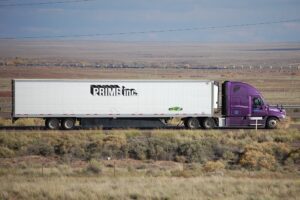
What’s The Difference Between Dry Van & Reefer Trucking?

What’s A Good Gift for A Truck Driver?

Truck Driver Exercises to Keep You Fit on the Road
Transportation solutions, carrier solutions, drive for prime, work in house, success leasing.
Created by: Campaignium
Privacy Overview
- Company Culture
- Company Programs
- Leadership Team
- Fleet Maintenance
- Refrigerated Division
- Flatbed Division
- Tanker Division
- Intermodal Division
- Load Tracing
- Documentation
- Qualifications & Expectations
- Pay & Benefits
- Driver Training Program
- CDL Holders
- Driver Awards
- Salt Lake City
- Pittston, PA
- Springfield, MO
- Jobs At Prime
- View Available Loads
- Prime Power Fleet
- Lease & Lease Purchase
- Benefits of Leasing
- How to Get Started
- Pedigree Benefits
- Financing Information
- Equipment Inventory
- Omnitracs Logs
- Company Store
- Submit Pics from the Road
- Driver Verification
Platform Overview
The Connected Operations Cloud
Apps & Driver Workflows
Messaging, dispatch, documents, ELD
Video-Based Safety
AI cameras, driver coaching, safety reports, in-cab alerts
Equipment Monitoring
Location tracking, utilization, continuous diagnostics
Vehicle Telematics
Real-time GPS, routing, fuel, maintenance, electrification
Site Visibility
Remote visibility, proactive alerting, on-the-go access
Integrations
Developer API
Start building with our API
App Marketplace
Install turnkey integrations
OEM Integrations
Unlock embedded telematics data
Experts Marketplace
Find certified Samsara experts
By Business Need
Reduce costs across your business
Automate regulatory compliance
Ensure safety wherever you operate
Identify and eliminate risks
Sustainability
Prepare for transition to renewables
Customer Experience
Build customer loyalty and retention
By Industry
Transportation & Logistics
Food & Beverage
Field Services
Construction
K-12 Schools
Higher Education
Passenger Transit
Customer Success
Customer Stories
Education & Training
Customer Support
Help Center
Developer Portal
Customer Tips
Case Study Highlight

DHL consolidates 7 separate point solutions with Samsara’s integrated platform
Read more ➔

Nutrien Ag Solutions
Nutrien Ag Solutions cuts distracted driving in half 90 days after installing AI Dash Cams
Video Library
Product Tours
Fleet Safety Guide
Business Resilience

State of Connected Operations
See how leaders are adopting cutting-edge technologies, empowering their workforce, and unlocking new revenue streams.
Optimization
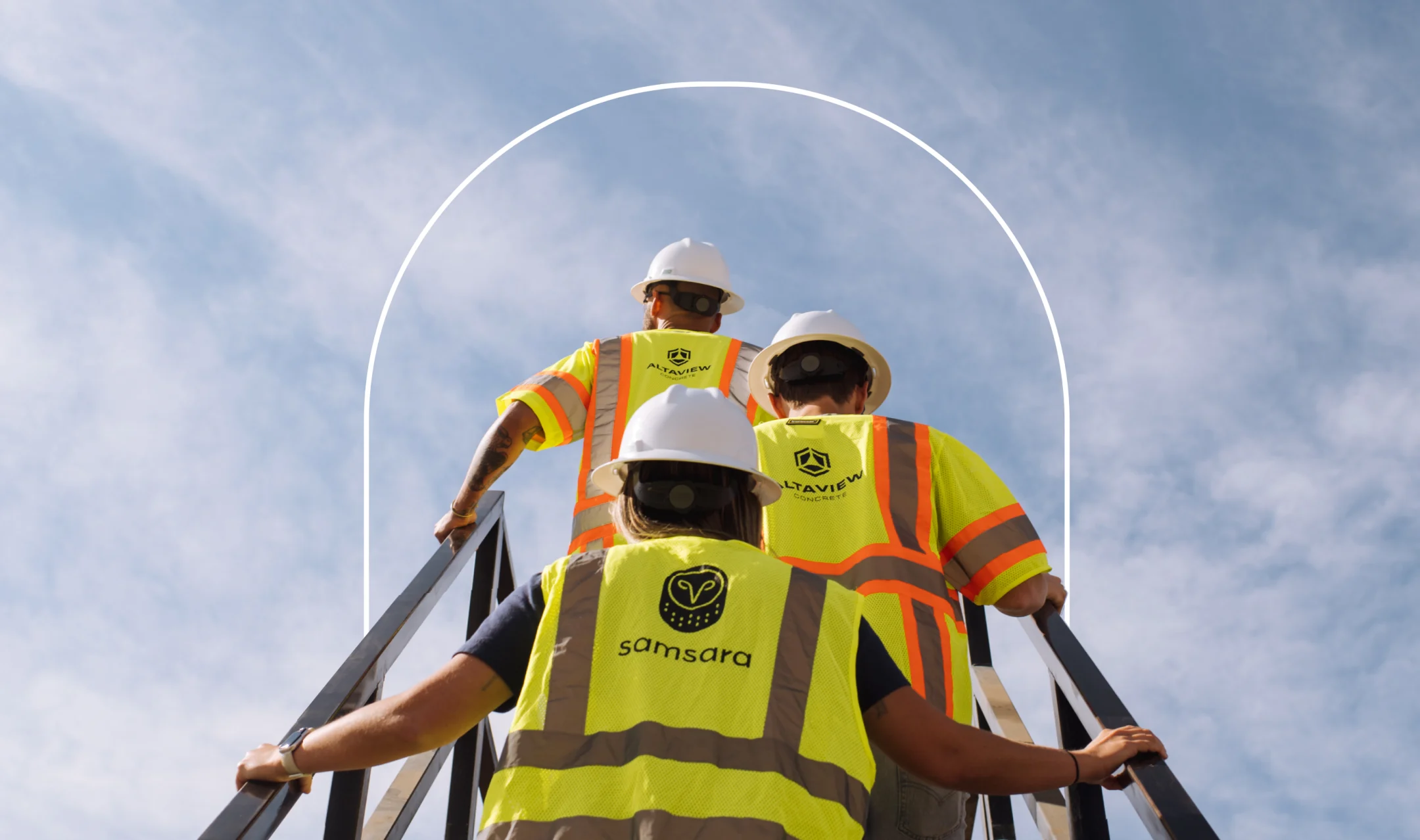
Make More Possible
Find ways to make more possible across your organization to empower your workers, increase efficiency, and reduce operational costs.
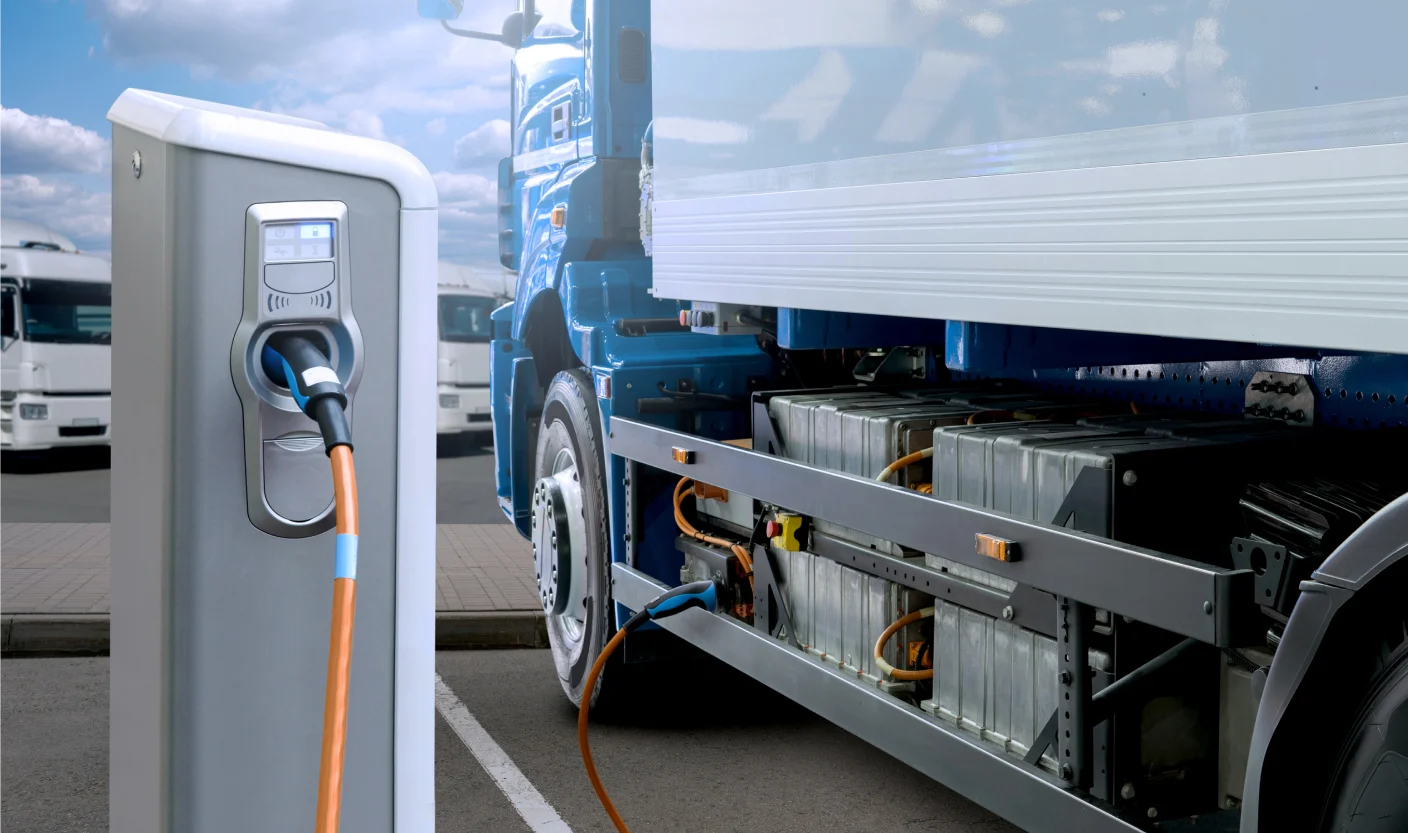
Build Your EV Fleet
Get the essentials on fleet electrification and better understand how an EV fleet can benefit your business.
Investor Relations
Samsara Ventures
Brand Assets
Featured News

Apply for the 2024 Connected Operations Awards

Samsara's 2023 Environmental, Social, and Governance (ESG) report
What is a Pre-Trip Inspection for Class B CDL?
October 22, 2021

Get Started With Samsara
Key Takeaways
Pre-trip inspections are an important part of a driver’s daily routine. For Class B commercial driver’s license (CDL) holders — many of whom drive passenger-carrying vehicles — a pre-trip inspection can help ensure everyone stays safe. Learn more about what’s involved in a Class B pre-trip inspection.
What is a pre-trip inspection?
A pre-trip inspection is a thorough review and examination of a commercial vehicle's major systems and parts before heading out on a route. Completing the pre-trip inspection is one of the most common and important tasks commercial drivers must perform. Drivers have to perform this vehicle inspection at the start of a new day, every 24-hours, and whenever they change vehicles. After completing this inspection, drivers must complete a driver vehicle inspection report (DVIR) recording the completed inspection.
Pre-trip inspections for class B licensees
The class B commercial driver’s license (CDL) covers both passenger carrying and non-passenger vehicles. These might include straight trucks, box trucks, large passenger buses, dump trucks, waste collection trucks, tractor-trailers and more. Depending on the vehicle driven, the class B pre-trip inspection may have slight variations.
The Department of Transportation (DOT) requires drivers to perform a pre-trip inspection before driving a commercial vehicle. Similar to Class A CDL holders, the actual daily pre-trip inspection takes about 15 minutes or less. Typically, the inspection includes the following with employer and business-specific inspections.
Brakes and air system
Steering mechanism
Lights and reflectors
Tires, wheels, and rims
Windshield wipers
Rearview mirrors
Emergency equipment
Class B CDL pre-trip inspection checklist
When getting a CDL, passing the pre-trip inspection test is much more intensive than the pre-trip inspections drivers perform while on the job. This pre-trip inspection checklist for a Class B CDL gives drivers an overview of what and how to perform an inspection. Check your state’s CDL manual for a complete list of inspection requirements.
See Class A pre-inspection checklist here.
Engine compartment
Fluids - coolant, oil, and power steering : Reservoirs and tanks should not leak. Check hoses for splits or cuts and that they are securely mounted on both ends. Verify proper fluid levels with a dipstick.
Belts - alternator, pumps, compressor : All belts should be securely mounted without cracks or frays. Belt should have no more than 1/2" to 3/4" of play.
Hoses (passenger and driver’s sides) : All hoses, including the power steering hose and coolant hose, should be secured on both ends. They should not have splits, cuts, or leaks.
Air compressor: May be difficult to see. Ensure it’s securely mounted, not broken, cracked or leaking.
Alternator : All wires are properly connected.
Water pump : All hoses are properly connected and not leaking.
Front of vehicle
Steering gearbox and hoses : No damage or leaks. Hose should be secured on both ends. They should not have splits, cuts, or leaks.
Steering shaft/steering column : Not bent or broken.
Pitman arm : All caste nuts and cotter pins are present and tight.
Drag link : Rubber is not split and properly greased.
Upper and lower control arms and tie rod : Tie rod should be secure, not cracked or bent.
Front suspension
Spring mounts/spring hanger : Not cracked or broken
Leaf springs : None are cracked, broken, or shifted.
U-bolts : All accounted for.
Shock absorber : No visible leaks. Leaks will show at the point where the top and bottom of the shock meet. Rubber is not split or shows signs of dry rot.
Airbag : Check rubber for abrasions, cuts or audible leaks plus any missing bolts.
Side of cab and under vehicle
Mirrors and bracket: Hardware attached properly. Mirror should be clean and not broken.
Door and hinges : Demonstrate door operations, latching properly, hinges intact. Door seals should not be torn or rotten.
Steps : Mounted properly and can hold weight.
Fuel tank: Not leaking; cap is tight with seal intact.
Catwalk (if applicable) : Properly mounted and clear of loose objects.
Baggage compartment (if applicable) : Demonstrate door operations, latching properly, hinges intact. Door seals should not be torn or rotten.
Drive shaft : Not twisted, U-joints not broken and free of debris.
Exhaust system: Not loose, no sign of leaks (exterior soot).
Frame : Nothing broken or unauthorized welds.
Brake system (both tractor and trailer)
Brake hose : Securely mounted on both ends. No splits, cuts, and not leaking audibly leaking air.
Brake chamber : Not audibly leaking air.
Slack adjuster and push rod : When brakes are released and pulled by hand, the push rod should have no more than 1” of play. It should stay at a 90° angle to the brake chamber.
Brake drum : No bluing from excessive heat.
Brake pads/brake lining : Check for oil and debris on the lining. Minimum brake pad thickness is ¼.”
Wheel system
Wheel rims : No unauthorized or illegal welds.
Steer tires : Look for cuts, bulges, and abrasions on the tread and sidewalls. Tread depth should be a minimum of 4/32”. Tread should be evenly worn. Check inflation levels on tires with an air gauge, filled to manufacturer’s specifications.
Drive tires : Look for cuts, bulges, and abrasions on the tread and sidewalls. Tread depth should be a minimum of 2/32”. Tread should be evenly worn. Check inflation levels on tires with an air gauge, filled to manufacturer’s specifications.
Valve stem . Properly secured, metal cap in place. Not audibly leaking air.
Lug nuts : All accounted for. Check for rust or cracks.
Hub seal/axle seal : Should not be loose. No visible leaks.
Spacing (if applicable) : There must be proper spacing between the tires if equipped with duals.
Rear suspension
Airbag : Check rubber for abrasions, cuts or audible leaks, plus any missing mounting bolts.
Torque arm/radius rod : Secure mounting, bushings intact.
Rear of vehicle
Doors and hinges (if applicable): Secured and should open, close and latch properly. Door seals have no separation, no rubber tubing sticking out.
Mudflap : Secured, not missing or broken. At the right height.
Check all lights on the front, both sides, vehicle rear. Turn on to ensure lights and reflectors are working.
Running lights : Walk around the vehicle to examine all.
High beams/low beams: Walk around the vehicle to examine all.
Turn signals : Signal both right turn and left turn. Walk around the vehicle to examine all.
Hazards/4-way flashers and clearance light : Walk around the vehicle to examine all.
Brake lights : Ask the examiner to watch brake lights. Confirma they worked using the side mirror.
License plate lights : Walk around the vehicle to examine all.
Reflector tapes : Clean and not worn. Walk around the vehicle to examine all.
Passenger items
Doors and hinges (if separate from driver door) : Secured and should open, close and latch properly. Door seals have no separation, no rubber tubing sticking out.
Wheelchair lift: No wear, damage, or other abnormal conditions.
Handrails and step lights : Handrail mounted firmly, bolts accounted for. Step lights are all working.
Emergency exits : Labeled and able to open and close. If there is an alarm for the door, ensure it works when the door is open.
Seating : Not torn, securely mounted.
School bus items
Student loading lights: Walk around the vehicle to examine all. None cracked or broken. All lights able to flash.
Stop/safety arm : Able to fully extend with lights
Student mirror : Secure, not cracked or broken. No obstructions and properly adjusted.
First aid and body fluid cleanup kit : Labeled and stocked with supplies. Nothing expired.
In-cab inspection and air brake test
Seat belt: No rips or frays and should adjust and latch properly.
Lighting indicators : See lights and reflectors section
Oil pressure indicator : Demonstrate normal operating range.
Water temperature gauge : Demonstrate normal operating range.
Air pressure gauges : Build to governor cut out.
Ammeter/voltmeter : Charging between 13 and 14 volts.
Mirrors : Secure, not cracked or broken. No obstructions and properly adjusted.
Windshield : No more than a 1” crack is permitted. Clean and free of debris.
Windshield wipers and washers: Turn on to show they are working properly.
Horns (city and air) : Show they are working properly.
Heater/defroster : Turn on to show they are working properly.
Safety/emergency equipment : Must have fire extinguisher, three red reflective triangles and spare electrical fuses. Extinguisher must be fully charged and secured.
Steering wheel : Secured to steering column.
Foot pedals : Free of grease and debris. No obstructions.
Hydraulic brake check : Pump the brake pedal several times. Apply pressure to the pedal and hold for five seconds. The pedal should not move.
Air brake check : Air brake devices vary. Drivers must test three components of the air brake check correctly: applied pressure, warning lights and buzzers, and valve pop-outs.
Parking brake: Apply and put the vehicle in low gear and try to move. Drivers must test separate brakes (tractor and trailer) individually.
Service brake : Release brakes. Drive 3 – 5 mph. Apply the service brake and come to a complete stop. Ensure steering does not pull to the left or right when applying the brakes.
Stay in touch
Sign up to learn more about Samsara.


IMAGES
VIDEO
COMMENTS
CDL Pre-Trip Inspection Checklist. Studying this Class-A CDL pre-trip inspection checklist is an important part of truck driver training. Before getting your Class-A CDL and finding an entry level truck driving job, most states will require students to pass a DOT (department of transportation) pre-trip inspection test and a general knowledge test. ...
Engine Compartment + 1 Axle. 3 L's. Leaks, Leans, and Lights. Before opening the hood, check for LEAKS on the ground, under the engine. Check that the truck is not LEANING. to one side or the other. Check the LIGHTS on the top and front of the truck. They must be the proper color and not cracked, broken, or dirty.
What is a pre-trip inspection? A pre-trip inspection includes checking over the tractor and trailer a truck driver will be operating. A pre-trip should be completed before the operation of a vehicle: At the beginning of a driver's shift. Any time a new trailer is picked up. After a 10-hour break. A thorough inspection usually takes anywhere ...
CDL Pre-Trip Inspection List. While the DOT isn't explicit with which items drivers are required to inspect during their pre-trip inspection, it is important to take a look at the following items: Service brakes, including trailer brake connections. Parking (hand) brake. Steering mechanism.
Due to heavy memorization, the pre-trip inspection is one of the hardest aspects of the CDL test. Also called the "Vehicle Inspection Test," the pre-trip is one of the tests that trucking students fail the most. With this pre-trip inspection checklist, we tell you everything you need to know and what you need to check for.
CDL Pre-Trip Inspection Checklist. Studying the Class-A CDL pre-trip inspection checklist is an important part of truck driver training. Before obtaining your Class A commercial driver's license and getting a truck driving job, most states require students to pass a DOT pre-trip inspection test and a CDL general knowledge test.
Air Brake Test. TRUCKINGTRUTH.COM. PRE-TRIP INSPECTION GUIDE. TT91. Air Brake Test. Warning Light and Buzzer Test. Pump down on the Brake pedal until the warning light and buzzer comes on, at or before 60 PSI. Announce: "This test was successful because my warning light and buzzer both came on at or before 60 PSI.".
Pre-Trip Inspection Study Guide. Our Pre-Trip Inspection Study Guide has everything you need to prepare for the Class A CDL Pre-Trip Inspection Exam. Our study guide will cover the pre-trip inspection terminology as well as a thorough list of all of the parts you will be inspecting on the vehicle. For each part you will be inspecting there will ...
Skills test. Pre-trip inspection. TSA background check. Retake policy. CDL Maintenance. ELDT Training & Certification. CDL how-to guides. Learn how to conduct thorough pre-trip inspections with our guide, a critical component for commercial vehicle safety.
CDL pre-trip inspection checklist. You can begin by inspecting the front of the vehicle from top to bottom. Next, you'll check the engine, opening the hood from the passenger's side. Your inspection will continue from front to back of the tractor and trailer, inspecting all parts listed below. Below is a detailed CDL pre-trip inspection ...
Pre-trip inspections are mandatory for every trip, and knowing how to conduct them is a core requirement to pass the CDL test. Whether you're an experienced trucker or preparing for the test, a pre-trip inspection checklist and fleet management software can be your best friends. Compare Top Fleet Management Software Leaders. Article Roadmap
Ideally, it takes 15-30 minutes to run through the CDL pre trip inspection checklist depending on experience level and whether or not any issues are found. If issues are found, they must be fixed right then, before taking any more loads. The cost of preventative maintenance averages $15,000 per truck per year.
A CLD pre-trip inspection checklist helps uncover potentially dangerous conditions, such as unsecured loads or problems with brakes or steering. While it might be tempting for experienced drivers to skip or shortcut a pre-trip vehicle inspection, it's never a good idea. "Better safe than sorry" should be the mantra 100% of the time, and ...
CDL Skills Test PRE-TRIP Inspection 7505 Dahlia St. Commerce City, CO 80022 303-227-7841 Engine Compartment + 1 Axle Side and Back of Truck + 1 Axle Connections and Trailer + 1 Axle External Light Check In-Cab with Brake Check Our YouTube videos are very popular. Go to YouTube and search for 'cdl college playlist'
The pre-trip inspection is an integral part of every road trip for a trucker. It's probably the most disliked and most often overlooked part of the job of the professional truck driver in the trucking industry. This inspection is meant to be a thorough check of the truck, trailer and load. The check is to ensure that everything is in correct ...
A CDL pre-trip inspection checklist systemizes the driver's vehicle inspection to ensure care and consistency. While a pre-trip inspection would be a best practice no matter what, the Federal Motor Carrier Safety Administration (FMCSA) requires these checks for commercial vehicles. Part 396.3 (a) calls on every motor carrier to ...
The standard CDL pre-trip DOT inspection checklist includes everything a commercial motor vehicle needs to navigate the road safely. These are generally suspension- and engine-related items that would just as well apply to a regular car. As a general rule, a commercial pre-trip inspection test almost always includes the following motor vehicle ...
Tractor-trailers can weigh up to 80,000 lb. if you count the semi, trailer and cargo.Operating a heavy tractor-trailer can be dangerous, so drivers undergo extensive training to earn their CDLs and start their careers.. Whether studying for your CDL test or heading to your next customer, pre-trip inspections help you catch problems with your vehicle or trailer.
CDL Skills Test PRE-TRIP Inspection 7505 Dahlia St. Commerce City, CO 80022 303-227-7841 Engine Compartment +1 Axle Side and Back of Truck +1 Axle Connections and Trailer +1 Axle External Light Check In-Cab with Brake Check. Leaks, Leans, Lights (3 L's) 3 Components Look for FINS!
A CDL pre-trip inspection checklist is used by truck drivers who hold a Commercial Drivers Licenses (CDL) to inspect each part of the vehicle before and during trips. A daily pre-trip inspection typically takes between 15 and 30 minutes to complete.
Prepare for your CDL Examination by learning from this video. This is a complete demonstration of performing pre-trip inspection of the entire tractor/traile...
What is a CDL pre-trip inspection checklist? A pre-trip inspection checklist helps truck drivers remember all the major systems and parts to inspect before heading out on a route. Knowing how to complete a pre-trip vehicle inspection is an important part of trucking. Pre-trip inspections for class A licensees
A pre-trip inspection is a thorough review and examination of a commercial vehicle's major systems and parts before heading out on a route. Completing the pre-trip inspection is one of the most common and important tasks commercial drivers must perform. Drivers have to perform this vehicle inspection at the start of a new day, every 24-hours ...